The Geochronology, Geochemical Characteristics, and Tectonic Settings of the Granites, Yexilinhundi, Southern Great Xing’an Range
Abstract
1. Introduction
2. Geological Setting
3. Materials and Methods
3.1. Sample Collection and Description
3.2. Analytical Methods
4. Results
4.1. Zircon U-Pb Dating
4.2. Geochemical Characteristics
4.3. Zircon Lu-Hf Isotope Analysis
5. Discussions
5.1. Metallogenic and Petrogenic Ages
5.2. Petrogenesis and Magma Source Region

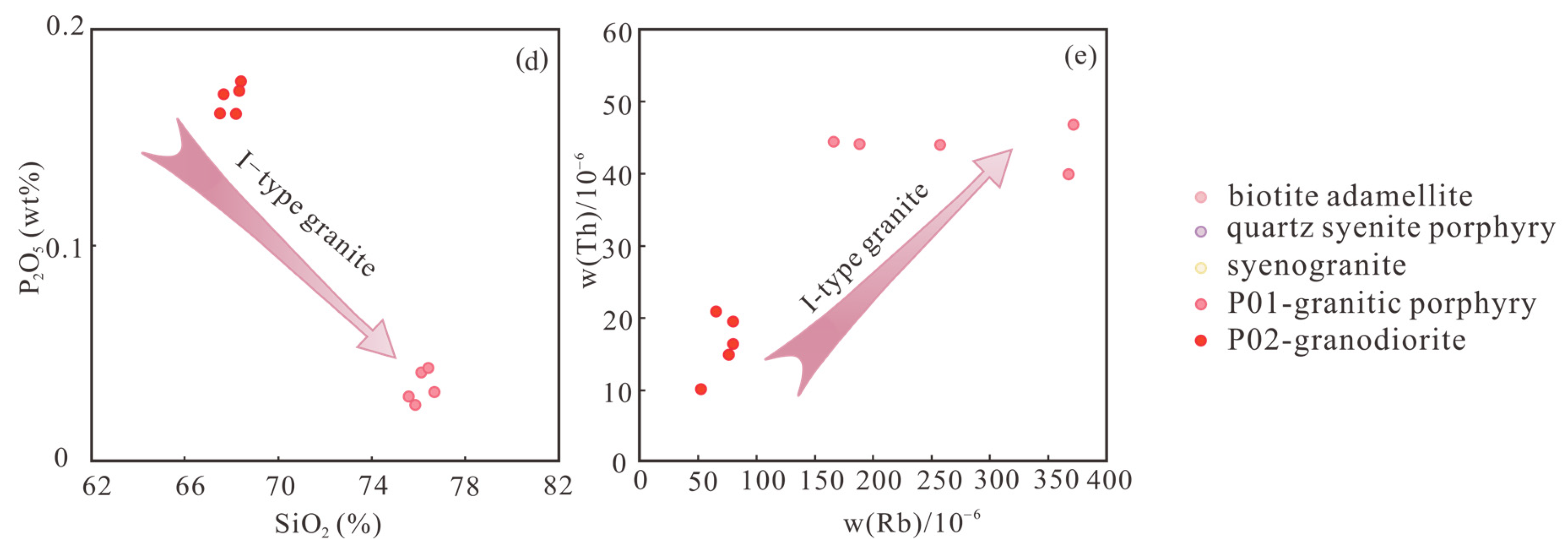
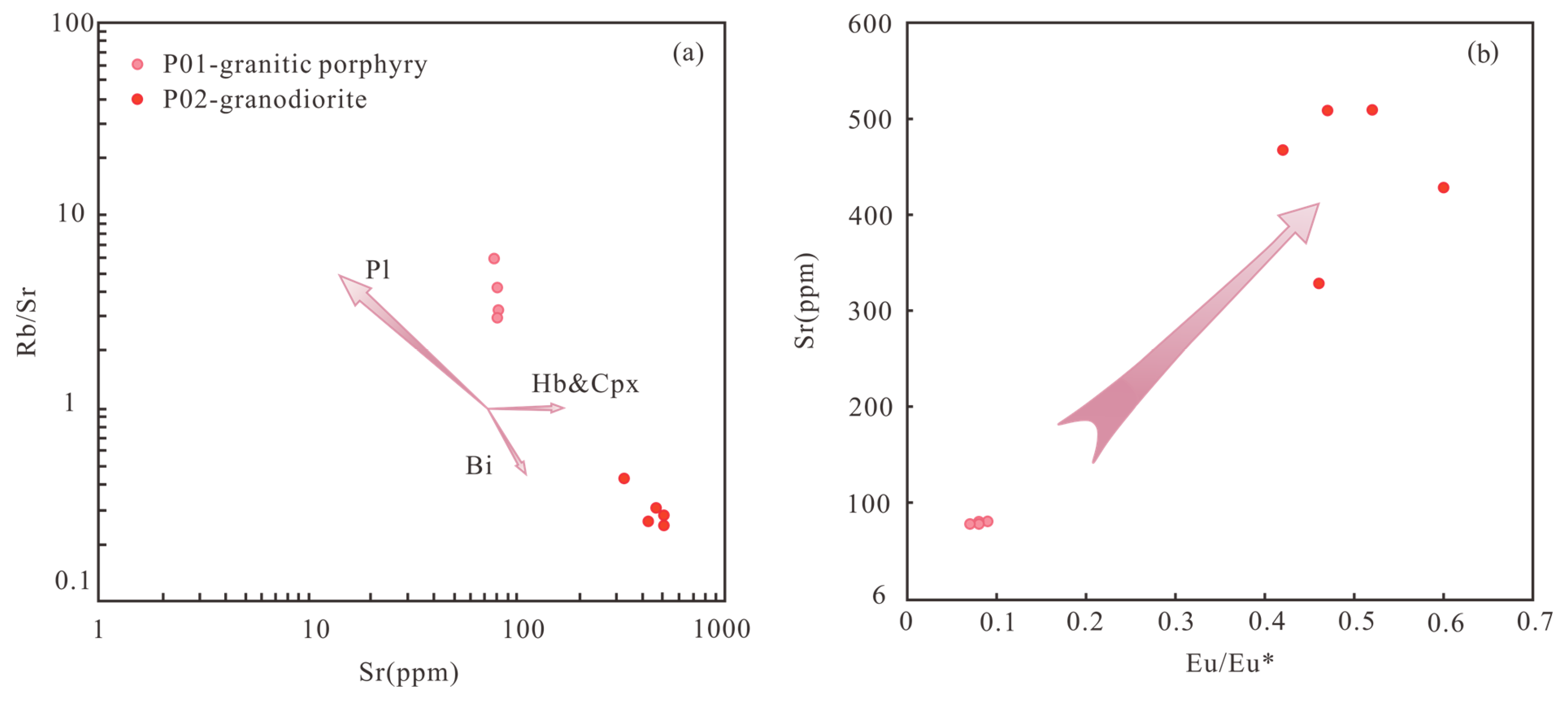
5.3. Tectonic Setting
6. Conclusions
- (1)
- Zircon LA-ICP-MS weighted mean ages of granite porphyry and granodiorite in the Yexilinhundi region are 145.0 ± 0.74 Ma (n = 8, MSWD = 6.1) and 150.3 ± 0.54 Ma (n = 21, MSWD = 0.21), respectively, belonging to Late Jurassic granites.
- (2)
- The Yexilinhundi granites are characterized by high SiO2 and alkali-rich, high DI, low CaO, as well as low Tzr. They are enriched in Rb, Th, and U, depleted in Ba and Ti, with δEu values ranging from 0.07 to 0.6, exhibiting features of highly fractionated I-type granites. These granites formed through partial melting of Mesoproterozoic-Neoproterozoic juvenile middle-upper crustal materials under mantle thermal influence, possibly with minor incorporation of mantle-derived components, and are closely associated with the formation of regional Sn polymetallic deposits.
- (3)
- The Late Jurassic granite porphyry and granodiorite in the Yexilinhundi region formed in a post-collisional/post-orogenic extensional setting, which is related to the subduction of the Mongol-Okhotsk Ocean.
Author Contributions
Funding
Data Availability Statement
Acknowledgments
Conflicts of Interest
Appendix A
| Analytical Spot Number | Pb | Th | U | Th/U | 206Pb/238U | ±1σ | 207Pb/235U | ±1σ | Ages | |||
|---|---|---|---|---|---|---|---|---|---|---|---|---|
| 10−6 | 206Pb/238U | ±1σ | 207Pb/235U | ±1σ | ||||||||
| granite porphyry(P01) | ||||||||||||
| 1 | 0.312 | 117.033 | 288.784 | 0.40 | 0.02127 | 0.00365 | 0.14901 | 0.00629 | 135.7 | 2.31 | 141.0 | 5.56 |
| 2 | 3.29 | 1071.53 | 3161.85 | 0.33 | 0.02265 | 0.00345 | 0.15000 | 0.00260 | 144.4 | 2.18 | 141.9 | 2.29 |
| 3 | 8.95 | 2122.48 | 8223.74 | 0.31 | 0.02274 | 0.00391 | 0.15215 | 0.00411 | 145.0 | 2.47 | 143.8 | 3.62 |
| 4 | 11.0 | 2182.16 | 9984.49 | 0.29 | 0.02280 | 0.00388 | 0.15658 | 0.00306 | 145.4 | 2.45 | 147.7 | 2.69 |
| 5 | 7.16 | 2419.12 | 4718.82 | 0.49 | 0.02449 | 0.00366 | 0.19252 | 0.00684 | 156.0 | 2.30 | 178.8 | 5.82 |
| 6 | 5.48 | 1563.07 | 4252.78 | 0.37 | 0.02281 | 0.00439 | 0.18612 | 0.00762 | 145.4 | 2.77 | 173.3 | 6.52 |
| 7 | 28.1 | 2895.43 | 9826.73 | 0.34 | 0.02610 | 0.00408 | 0.34338 | 0.00731 | 166.1 | 2.56 | 299.7 | 5.53 |
| 8 | 9.33 | 1514.42 | 3848.18 | 0.38 | 0.02321 | 0.00322 | 0.30598 | 0.00709 | 147.9 | 2.03 | 271.1 | 5.52 |
| granodiorite(P02) | ||||||||||||
| 1 | 0.957 | 331.675 | 800.591 | 0.41 | 0.02344 | 0.000365 | 0.16048 | 0.00382 | 149.4 | 2.30 | 151.1 | 3.34 |
| 2 | 1.00 | 293.654 | 846.171 | 0.34 | 0.02351 | 0.000424 | 0.16086 | 0.00381 | 149.8 | 2.67 | 151.5 | 3.34 |
| 3 | 1.15 | 350.706 | 1014.77 | 0.35 | 0.02351 | 0.000385 | 0.16259 | 0.00500 | 149.8 | 2.42 | 153.0 | 4.37 |
| 4 | 1.11 | 304.262 | 917.302 | 0.33 | 0.02353 | 0.000305 | 0.15902 | 0.00424 | 149.9 | 1.92 | 149.8 | 3.72 |
| 5 | 0.816 | 235.029 | 639.213 | 0.36 | 0.02354 | 0.000336 | 0.16205 | 0.00540 | 150.0 | 2.12 | 152.5 | 4.72 |
| 6 | 0.722 | 200.752 | 623.853 | 0.32 | 0.02354 | 0.000462 | 0.16338 | 0.00706 | 150.0 | 2.91 | 153.7 | 6.17 |
| 7 | 1.16 | 406.962 | 921.981 | 0.43 | 0.02354 | 0.000459 | 0.15729 | 0.00557 | 150.0 | 2.89 | 148.3 | 4.89 |
| 8 | 1.05 | 344.514 | 910.598 | 0.37 | 0.02356 | 0.000487 | 0.15908 | 0.00435 | 150.1 | 3.07 | 149.9 | 3.81 |
| 9 | 0.930 | 294.662 | 741.177 | 0.38 | 0.02357 | 0.000391 | 0.16042 | 0.00388 | 150.2 | 2.46 | 151.1 | 3.40 |
| 10 | 0.612 | 157.352 | 587.036 | 0.28 | 0.02358 | 0.000633 | 0.15816 | 0.00767 | 150.2 | 3.99 | 149.1 | 6.72 |
| 11 | 1.00 | 302.814 | 806.818 | 0.37 | 0.02359 | 0.000325 | 0.16002 | 0.00511 | 150.3 | 2.05 | 150.7 | 4.48 |
| 12 | 1.23 | 380.496 | 1066.36 | 0.36 | 0.02363 | 0.000434 | 0.15789 | 0.00380 | 150.6 | 2.73 | 148.9 | 3.34 |
| 13 | 0.711 | 190.763 | 528.694 | 0.34 | 0.02363 | 0.000347 | 0.16162 | 0.00414 | 150.6 | 2.19 | 152.1 | 3.62 |
| 14 | 1.22 | 419.804 | 1041.51 | 0.39 | 0.02364 | 0.000391 | 0.15853 | 0.00354 | 150.6 | 2.46 | 149.4 | 3.10 |
| 15 | 1.10 | 428.326 | 933.125 | 0.45 | 0.02364 | 0.000396 | 0.15899 | 0.00383 | 150.6 | 2.49 | 149.8 | 3.35 |
| 16 | 0.295 | 84.4611 | 244.882 | 0.35 | 0.02365 | 0.000509 | 0.16486 | 0.00989 | 150.7 | 3.21 | 154.9 | 8.62 |
| 17 | 1.97 | 232.002 | 820.496 | 0.28 | 0.02366 | 0.000353 | 0.15781 | 0.00386 | 150.8 | 2.22 | 148.8 | 3.38 |
| 18 | 1.13 | 421.531 | 1002.51 | 0.40 | 0.02369 | 0.000540 | 0.15895 | 0.00495 | 150.9 | 3.40 | 149.8 | 4.34 |
| 19 | 1.74 | 852.555 | 1438.63 | 0.57 | 0.02369 | 0.000387 | 0.16374 | 0.00306 | 150.9 | 2.44 | 154.0 | 2.67 |
| 20 | 1.01 | 305.131 | 879.734 | 0.35 | 0.02370 | 0.000347 | 0.15794 | 0.00343 | 151.0 | 2.19 | 148.9 | 3.01 |
| 21 | 1.31 | 470.858 | 1242.78 | 0.39 | 0.02371 | 0.000591 | 0.15935 | 0.00554 | 151.1 | 3.72 | 150.1 | 4.85 |
| Testing Items | P01-1 | P01-2 | P01-3 | P01-4 | P01-5 | P02-1 | P02-2 | P02-3 | P02-4 | P02-5 |
|---|---|---|---|---|---|---|---|---|---|---|
| Al2O3 | 11.83 | 12.23 | 11.79 | 12.24 | 12.29 | 15.36 | 16.08 | 15.91 | 15.92 | 15.36 |
| SiO2 | 76.12 | 76.68 | 75.58 | 75.86 | 76.42 | 68.20 | 67.67 | 68.33 | 68.41 | 67.51 |
| CaO | 0.324 | 0.214 | 0.281 | 0.134 | 0.218 | 0.694 | 1.14 | 1.36 | 0.98 | 1.09 |
| K2O | 5.17 | 4.14 | 7.58 | 7.38 | 3.87 | 2.21 | 2.37 | 2.03 | 2.07 | 1.77 |
| Fe2O3 | 1.28 | 1.28 | 1.11 | 1.18 | 0.907 | 3.95 | 3.61 | 3.36 | 3.58 | 4.27 |
| FeO | 0.18 | 0.26 | 0.12 | 0.12 | 0.72 | 0.92 | 0.16 | 0.12 | 0.24 | 1.0 |
| MgO | 0.309 | 0.312 | 0.307 | 0.269 | 0.355 | 1.42 | 1.03 | 1.02 | 1.16 | 1.31 |
| MnO | 0.03 | 0.03 | 0.03 | 0.03 | 0.04 | 0.08 | 0.09 | 0.1 | 0.09 | 0.08 |
| Na2O | 3.14 | 3.82 | 1.39 | 1.71 | 3.97 | 4.78 | 4.73 | 4.91 | 4.86 | 5.02 |
| P2O5 | 0.041 | 0.032 | 0.030 | 0.026 | 0.043 | 0.16 | 0.17 | 0.17 | 0.18 | 0.16 |
| TiO2 | 0.12 | 0.12 | 0.086 | 0.097 | 0.14 | 0.58 | 0.61 | 0.65 | 0.67 | 0.53 |
| Total | 98.54 | 99.11 | 98.31 | 99.05 | 98.97 | 98.35 | 97.66 | 97.95 | 98.14 | 98.09 |
| LOI | 1.02 | 0.985 | 1.15 | 0.949 | 1.12 | 2.77 | 2.56 | 2.44 | 2.47 | 2.67 |
| K2O + Na2O | 8.31 | 7.95 | 8.97 | 9.09 | 7.84 | 6.98 | 7.10 | 6.94 | 6.93 | 6.79 |
| A/NK | 1.10 | 1.14 | 1.12 | 1.13 | 1.15 | 1.50 | 1.55 | 1.55 | 1.56 | 1.51 |
| A/CNK | 1.05 | 1.10 | 1.08 | 1.12 | 1.12 | 1.38 | 1.34 | 1.29 | 1.37 | 1.30 |
| AR | 3.14 | 4.18 | 6.79 | 6.54 | 4.36 | 2.54 | 2.40 | 2.34 | 2.39 | 2.41 |
| DI | 95.32 | 95.13 | 95.48 | 95.17 | 94.68 | 82.66 | 82.95 | 82.76 | 83.18 | 78.71 |
| SI | 3.09 | 3.18 | 2.96 | 2.42 | 3.67 | 10.85 | 8.81 | 9.07 | 9.91 | 9.97 |
| Li | 25.93 | 32.19 | 31.58 | 24.15 | 33.36 | 45.76 | 40.43 | 38.21 | 44.17 | 38.20 |
| Be | 5.43 | 3.88 | 2.68 | 3.16 | 3.64 | 3.20 | 4.00 | 3.70 | 3.99 | 3.35 |
| Sc | 2.12 | 2.67 | 1.36 | 1.60 | 2.76 | 7.34 | 6.55 | 7.71 | 8.21 | 6.01 |
| Ti | 754.06 | 733.37 | 554.76 | 630.41 | 814.07 | 3256.0 | 3591.1 | 3611.8 | 3571.0 | 2880.8 |
| V | 11.15 | 10.97 | 11.05 | 10.14 | 12.66 | 50.91 | 43.98 | 45.34 | 49.77 | 40.71 |
| Mn | 204.63 | 216.87 | 202.31 | 218.05 | 267.82 | 581.15 | 688.27 | 714.55 | 606.26 | 558.02 |
| Co | 2.04 | 1.72 | 1.59 | 1.43 | 2.15 | 9.49 | 7.46 | 4.35 | 4.72 | 12.7 |
| Ni | 28.8 | 7.91 | 17.7 | 10.6 | 7.69 | 6.13 | 36.2 | 9.70 | 13.8 | 8.64 |
| Cu | 3.81 | 4.03 | 4.12 | 3.29 | 3.66 | 87.8 | 39.2 | 19.4 | 18.7 | 126 |
| Zn | 65.96 | 83.31 | 71.92 | 76.62 | 67.35 | 58.45 | 58.96 | 60.41 | 57.15 | 58.07 |
| Ga | 16.53 | 20.50 | 15.56 | 15.57 | 20.12 | 20.02 | 21.46 | 19.91 | 19.70 | 20.24 |
| As | 7.37 | 7.19 | 11.0 | 10.5 | 5.61 | 15.7 | 7.95 | 3.36 | 3.32 | 34.8 |
| Rb | 339.91 | 262.46 | 463.03 | 467.96 | 237.39 | 140.60 | 140.86 | 124.64 | 140.98 | 109.98 |
| Sr | 81.27 | 82.04 | 78.30 | 78.20 | 81.30 | 328.1 | 509.7 | 508.7 | 467.5 | 428.2 |
| Y | 44.63 | 47.76 | 32.78 | 36.06 | 44.78 | 18.14 | 16.55 | 17.34 | 18.21 | 19.48 |
| Zr | 144.48 | 145.50 | 144.90 | 147.83 | 149.18 | 163.19 | 178.53 | 165.69 | 179.31 | 138.96 |
| Nb | 29.7 | 30.6 | 28.8 | 30.9 | 30.0 | 8.26 | 8.67 | 8.69 | 8.39 | 7.36 |
| Mo | 11.3 | 4.74 | 11.6 | 4.93 | 4.07 | 1.48 | 25.3 | 2.78 | 9.14 | 1.30 |
| Cd | 0.51 | 0.60 | 0.46 | 0.39 | 0.79 | 0.54 | 0.60 | 0.51 | 0.55 | 0.56 |
| Cs | 5.74 | 4.35 | 8.24 | 8.47 | 4.04 | 7.41 | 6.31 | 6.05 | 6.71 | 6.27 |
| Ba | 133.88 | 118.72 | 129.97 | 114.28 | 122.05 | 241.18 | 302.06 | 241.55 | 227.26 | 196.05 |
| La | 5.18 | 4.24 | 4.97 | 3.36 | 3.07 | 16.1 | 18.2 | 22.1 | 21.4 | 16.4 |
| Ce | 27.48 | 21.41 | 17.53 | 20.43 | 23.35 | 41.26 | 41.18 | 48.24 | 51.13 | 33.66 |
| Pr | 2.79 | 2.43 | 2.30 | 1.99 | 1.98 | 4.17 | 4.54 | 5.10 | 5.29 | 4.20 |
| Nd | 13.66 | 12.33 | 12.11 | 10.33 | 10.62 | 17.62 | 19.66 | 21.12 | 22.62 | 18.25 |
| Sm | 5.33 | 5.09 | 4.10 | 4.13 | 4.32 | 3.74 | 3.92 | 3.98 | 4.27 | 3.84 |
| Eu | 0.15 | 0.13 | 0.10 | 0.091 | 0.13 | 0.53 | 0.62 | 0.57 | 0.54 | 0.71 |
| Gd | 4.83 | 4.56 | 3.54 | 3.72 | 4.00 | 3.26 | 3.42 | 3.53 | 3.67 | 3.42 |
| Tb | 1.2 | 1.1 | 0.83 | 0.94 | 1.0 | 0.56 | 0.56 | 0.58 | 0.61 | 0.59 |
| Dy | 8.29 | 8.26 | 5.91 | 6.92 | 7.74 | 3.30 | 3.19 | 3.17 | 3.40 | 3.49 |
| Ho | 1.7 | 1.8 | 1.3 | 1.5 | 1.7 | 0.70 | 0.64 | 0.67 | 0.72 | 0.75 |
| Er | 4.69 | 5.02 | 3.47 | 3.99 | 4.74 | 1.99 | 1.89 | 1.90 | 2.03 | 2.13 |
| Tm | 0.79 | 0.87 | 0.56 | 0.66 | 0.82 | 0.29 | 0.27 | 0.28 | 0.30 | 0.32 |
| Yb | 4.77 | 5.64 | 3.60 | 4.06 | 5.26 | 1.86 | 1.78 | 1.82 | 1.93 | 2.19 |
| Lu | 0.74 | 0.83 | 0.53 | 0.59 | 0.79 | 0.30 | 0.30 | 0.29 | 0.30 | 0.35 |
| Hf | 8.17 | 7.66 | 7.52 | 8.24 | 7.58 | 4.59 | 5.08 | 4.65 | 4.95 | 3.90 |
| Ta | 3.51 | 3.44 | 3.41 | 3.61 | 3.42 | 1.00 | 1.08 | 1.10 | 1.05 | 0.906 |
| W | 0.66 | 0.60 | 0.87 | 0.96 | 0.61 | 5.0 | 3.0 | 1.3 | 2.7 | 1.4 |
| Tl | 2.86 | 2.17 | 4.30 | 4.27 | 1.94 | 1.33 | 1.09 | 1.01 | 1.20 | 0.99 |
| Pb | 36.71 | 35.55 | 40.53 | 33.09 | 39.81 | 12.51 | 18.97 | 20.23 | 21.25 | 13.47 |
| Bi | 0.466 | 1.09 | 0.737 | 0.425 | 0.754 | 2.18 | 2.29 | 0.685 | 0.514 | 3.56 |
| Th | 43.77 | 43.95 | 39.77 | 46.60 | 44.23 | 14.84 | 16.22 | 20.73 | 19.35 | 9.963 |
| U | 8.21 | 7.08 | 7.77 | 8.81 | 7.87 | 1.76 | 1.64 | 1.77 | 1.76 | 1.63 |
| Zr + Ce + Nb + Y | 246.24 | 245.29 | 224.01 | 235.19 | 247.32 | 230.85 | 244.94 | 239.96 | 257.03 | 199.46 |
| ΣREE | 81.56 | 73.74 | 60.83 | 62.68 | 69.53 | 95.62 | 100.2 | 113.4 | 118.2 | 90.28 |
| ΣLREE | 54.59 | 45.63 | 41.12 | 40.33 | 43.47 | 83.37 | 88.14 | 101.1 | 105.3 | 77.04 |
| ΣHREE | 26.96 | 28.11 | 19.71 | 22.34 | 26.07 | 12.25 | 12.04 | 12.23 | 12.97 | 13.24 |
| ΣLREE/ΣHREE | 2.02 | 1.62 | 2.09 | 1.81 | 1.67 | 6.80 | 7.32 | 8.27 | 8.12 | 5.82 |
| δEu | 0.09 | 0.08 | 0.08 | 0.07 | 0.09 | 0.5 | 0.5 | 0.5 | 0.4 | 0.6 |
| TZr(℃) | 783 | 788 | 786 | 791 | 791 | 806 | 811 | 801 | 814 | 816 |
| (La/Yb)n | 0.78 | 0.54 | 0.99 | 0.59 | 0.42 | 6.2 | 7.3 | 8.7 | 8.0 | 5.4 |
| 10,000Ga/Al | 2.64 | 3.17 | 2.49 | 2.40 | 3.09 | 2.46 | 2.52 | 2.36 | 2.34 | 2.49 |
| Pointnumber | 176Yb/177Hf | 2σ | 176Lu/177Hf | 2σ | 176Hf/177Hf | 2σ | t(Ma) | εHf(0) | εHf(t) | TDM | TDM2 | fLu/Hf |
|---|---|---|---|---|---|---|---|---|---|---|---|---|
| P01-01 | 0.20962 | 0.00209 | 0.004884 | 0.000069 | 0.282817 | 0.000021 | 135.7 | 1.60 | 4.15 | 687 | 925.0 | −0.85 |
| P01-02 | 0.12908 | 0.00185 | 0.003379 | 0.000085 | 0.282912 | 0.000020 | 144.4 | 4.95 | 7.81 | 514 | 698.0 | −0.90 |
| P01-03 | 0.19397 | 0.00184 | 0.004829 | 0.000095 | 0.282712 | 0.000023 | 145.0 | −2.13 | 0.600 | 851 | 1158 | −0.85 |
| P01-04 | 0.18467 | 0.00231 | 0.004787 | 0.00012 | 0.282755 | 0.000022 | 145.4 | −0.600 | 2.13 | 782 | 1060 | −0.86 |
| P01-07 | 0.20444 | 0.00265 | 0.005145 | 0.000056 | 0.282761 | 0.000021 | 166.1 | −0.390 | 2.70 | 781 | 1040 | −0.85 |
| P02-1 | 0.057555 | 0.000509 | 0.001722 | 0.000032 | 0.282888 | 0.000017 | 150.9 | 4.11 | 7.24 | 525 | 737.0 | −0.95 |
| P02-2 | 0.046846 | 0.000743 | 0.001344 | 0.0000060 | 0.282905 | 0.000014 | 151.0 | 4.71 | 7.92 | 495 | 696.0 | −0.96 |
| P02-3 | 0.041128 | 0.000609 | 0.001287 | 0.000032 | 0.282892 | 0.000018 | 151.1 | 4.26 | 7.46 | 513 | 725.0 | −0.96 |
| P02-5 | 0.041463 | 0.000298 | 0.001272 | 0.000021 | 0.282869 | 0.000017 | 149.8 | 3.43 | 6.58 | 546 | 778.0 | −0.96 |
| P02-6 | 0.051415 | 0.000364 | 0.001520 | 0.000019 | 0.282869 | 0.000015 | 149.4 | 3.42 | 6.57 | 550 | 781.0 | −0.95 |
| P02-7 | 0.050463 | 0.000582 | 0.001530 | 0.000031 | 0.282908 | 0.000020 | 150.7 | 4.82 | 7.98 | 494 | 692.0 | −0.95 |
| P02-8 | 0.042130 | 0.000421 | 0.001299 | 0.000015 | 0.282884 | 0.000015 | 150.0 | 3.95 | 7.12 | 526 | 746.0 | −0.96 |
| P02-9 | 0.049939 | 0.00211 | 0.001421 | 0.000039 | 0.282867 | 0.000016 | 150.6 | 3.37 | 6.53 | 551 | 783.0 | −0.96 |
| P02-11 | 0.049323 | 0.000282 | 0.001476 | 0.000027 | 0.282862 | 0.000016 | 150.6 | 3.17 | 6.35 | 560 | 797.0 | −0.96 |
| P02-12 | 0.052500 | 0.000677 | 0.001448 | 0.000028 | 0.282779 | 0.000019 | 150.2 | 0.260 | 3.41 | 677 | 982.0 | −0.96 |
| P02-13 | 0.057691 | 0.00139 | 0.001685 | 0.000018 | 0.282848 | 0.000015 | 149.9 | 2.70 | 5.84 | 582 | 828.0 | −0.95 |
| P02-14 | 0.050892 | 0.000216 | 0.001429 | 0.000019 | 0.282862 | 0.000015 | 150.0 | 3.17 | 6.34 | 559 | 796.0 | −0.96 |
| P02-15 | 0.051961 | 0.000723 | 0.001462 | 0.000019 | 0.282941 | 0.000016 | 150.1 | 5.99 | 9.14 | 445 | 616.0 | −0.96 |
| P02-16 | 0.034350 | 0.00130 | 0.001040 | 0.000021 | 0.282845 | 0.000014 | 150.3 | 2.59 | 5.78 | 577 | 832.0 | −0.97 |
| P02-18 | 0.037349 | 0.000239 | 0.001082 | 0.000023 | 0.282856 | 0.000016 | 150.8 | 2.96 | 6.18 | 562 | 807.0 | −0.97 |
| Study Area | Type | Method | Subject(s) | Ages (Ma) | References |
|---|---|---|---|---|---|
| Baerzhe | rock mass | Rb-Sr isotope dating | Riebeckite granite | 125 | [140] |
| Xilinhaote | rock mass | Zircon SHRIMP U-Pb dating | A-type miarolitic granite | 276 ± 2 | [141] |
| Wulanhaote | rock mass | Zircon U-Pb dating | Biotite granodiorite | 174 ± 4 | [142] |
| Wulanhaote | rock mass | Zircon U-Pb dating | Biotite granodiorite | 182 ± 3 | [142] |
| Wulanhaote | rock mass | Zircon U-Pb dating | Biotite granodiorite | 222 ± 5 | [142] |
| Wulanhaote | rock mass | Zircon U-Pb dating | Hornblende alkali-feldspar granite | 229 ± 3 | [142] |
| Mengentaolegai | rock mass | Zircon U-Pb dating | Biotite granite | 281 ± 11 | [143] |
| Mengentaolegai | rock mass | Zircon U-Pb dating | Muscovite granite | 281 ± 3 | [143] |
| Baiyingaole | rock mass | Zircon U-Pb dating | Meilindaba rock mass | 313 ± 5 | [144] |
| Baiyingaole | rock mass | Zircon U-Pb dating | Wulangou rock mass | 315 ± 4 | [144] |
| Baiyingaole | rock mass | Zircon U-Pb dating | Baiyingaole rock mass | 323 ± 4 | [144] |
| Linxi | rock mass | Zircon U-Pb dating | Granite | 241 ± 3.2 | [145] |
| Xiwuqi | rock mass | Zircon U-Pb dating | Medium-fine grained quartz diorite | 325 ± 3 | [146] |
| Xiwuqi | rock mass | Zircon U-Pb dating | Medium-coarse grained quartz diorite | 322 ± 3 | [146] |
| Beidashan | rock mass | Zircon SHRIMP U-Pb dating | Beidashan granite mass | 140 ± 3 | [147] |
| Baiyingaole | rock mass | Zircon SHRIMP U-Pb dating | Quartz diorite | 326 ± 3 | [147] |
| Weilasituo | ore body | 40Ar-39Ar dating | Muscovite | 133.4 ± 1 | [148] |
| Taipinggou | ore body | Re-Os isotope dating | Molybdenite | 130 ± 1 | [149] |
| Weilasituo | rock mass | Zircon U-Pb dating | Diorite | 310 ± 2 | [150] |
| Weilasituo | rock mass | Zircon U-Pb dating | Quartz diorite | 311 ± 2 | [150] |
| Bairendaba | rock mass | Zircon U-Pb dating | Granite porphyry | 319 ± 3 | [150] |
| Banlishan | rock mass | Zircon U-Pb dating | Granodiorite porphyry | 133.5 ± 1.7 | [151] |
| Banlishan | rock mass | Zircon U-Pb dating | Rhyolite porphyry | 160 ± 2 | [151] |
| Huanggang | ore body | Re-Os isotope dating | Molybdenite | 135.31 ± 0.85 | [152] |
| Baiyinnuoer | rock mass | Zircon LA-MC-ICP-MS dating | Granodiorite (porphyry) | 244.5 ± 0.9 | [153] |
| Baiyinnuoer | rock mass | Zircon LA-MC-ICP-MS dating | Quartz porphyry | 134.8 ± 1.2 | [153] |
| Aoergai | rock mass | Zircon U-Pb dating | Granite porphyry | 245.4 ± 1.8 | [154] |
| Huanggangliang | ore body | Re-Os isotope dating | Molybdenite | 134.9 ± 5.2 | [155] |
| Huanggang | rock mass | Zircon U-Pb dating | Potassic granite | 136.7 ± 1.1 | [156] |
| Huanggang | rock mass | Zircon U-Pb dating | Granite porphyry | 136.8 ± 0.57 | [156] |
| Dajing | ore body | Cassiterite U-Pb dating | Tin-rich ore body | 144 ± 16 | [157] |
| Hongling | ore body | Re-Os isotope dating | Spotted molybdenite | 139.9 ± 2.3 | [158] |
| Huanggang | rock mass | Zircon U-Pb dating | Potassic granite | 139.96 ± 0.87 | [159] |
| Bianjiadayuan | rock mass | Zircon U-Pb dating | Granite porphyry | 143.2 ± 1.5 | [160] |
| Beidashan | rock mass | Zircon U-Pb dating | Biotite granite | 140 ± 3 | [161] |
| Beidashan | rock mass | Zircon U-Pb dating | Biotite granite | 139 ± 2 | [161] |
| Weilasituo | ore body | Molybdenite Re-Os dating | Greisen mineralization | 135 ± 11 | [161] |
| Weilasituo | ore body | Muscovite40Ar-39Ar dating | Vein-type ore | 129.5 ± 0.9 | [161] |
| Shuangjianzihan | rock mass | Zircon U-Pb dating | Granite porphyry | 134 ± 1.2 | [60] |
| Weilasituo | ore body | Cassiterite U-Pb dating | Vein-type ore | 135 ± 6 | [33] |
| Haobugao | rock mass | Zircon U-Pb dating | Granite | 142.6 ± 1.6 | [162] |
| Bianjiadayuan | ore body | Molybdenite Re-Os dating | Vein-type ore | 140 ± 0.7 | [163] |
| Daolundaba | ore body | Cassiterite U-Pb dating | Tin ore | 144.3 ± 1.9 | [164] |
| Weilasituo | ore body | Molybdenite Re-Os dating | Vein-type ore | 129 ± 4.6 | [165] |
| Weilasituo | ore body | Molybdenite Re-Os dating | Vein-type ore | 135 ± 7 | [166] |
| Baogaigou | rock mass | Zircon U-Pb dating | Granite | 145.6 ± 0.8 | [167] |
| Baiyinnuoer | rock mass | Zircon U-Pb dating | Granodiorite | 248 ± 1.3 | [168] |
| Baiyinnuoer | rock mass | Zircon U-Pb dating | Diorite | 249 ± 1.4 | [168] |
| Bairendaba | rock mass | Zircon U-Pb dating | Gabbro | 248 ± 2.7 | [168] |
| Daolundaba | rock mass | Zircon U-Pb dating | Fine-grained granite | 136.1 ± 0.4 | [34] |
| Daolundaba | rock mass | Zircon U-Pb dating | Granite porphyry | 134 ± 6.6 | [34] |
| Maodeng | ore body | Zircon U-Pb dating | Vein-type ore | 139 ± 0.2 | [169] |
| Anle | ore body | Zircon U-Pb dating | Vein-type ore | 146.8 ± 2.2 | [170] |
| Qianjinchang | rock mass | Zircon U-Pb dating | Biotite monzogranite | 278 ± 1 | [63] |
| Qianjinchang | rock mass | Zircon U-Pb dating | Biotite monzogranite | 279 ± 1 | [63] |
| Haobugao | rock mass | Zircon U-Pb dating | Granite porphyry | 134 ± 0.6 | [36] |
| Haobugao | rock mass | Zircon U-Pb dating | Granite porphyry | 133.4 ± 0.9 | [36] |
References
- Wu, G.; Zhang, T.; Chen, Z.Y.; Wu, L.W.; Chen, Y.C. Ore–Forming Age, Genesis, and Metallogenic Model of Sn Polymetallic Deposits in the Southern Great Xing’an Range. West. Resour. 2022, 151, 105226. [Google Scholar]
- Chen, G.Z.; Wu, G.; Wu, W.H.; Zhang, T.; Li, T.G.; Liu, Q.L.; Wu, L.W.; Pei, Z.C.; Jiang, B.; Wang, Z.L. Fluid inclusion study and isotope characteristics of the Daolundaba copper-polymetallic deposit in the southern Great Xing’an Range. Earth Sci. Front. 2018, 25, 202–221. [Google Scholar]
- Mao, J.W.; Liu, P.; Goldfarb, R.J.; Goryachev, N.A.; Pirajno, F.; Zheng, W.; Zhou, M.F.; Zhao, C.; Xie, G.Q.; Yuan, S.D.; et al. Cretaceous large-scale metal accumulation triggered by post-subductional large-scale extension, East Asia. Ore Geol. Rev. 2021, 136, 104270. [Google Scholar] [CrossRef]
- Wang, T.; Guo, L.; Zheng, Y.D.; Donskaya, T.; Gladkochub, D.; Zeng, L.S.; Li, J.B.; Wang, Y.B.; Mazukabzov, A. Timing and processes of late Mesozoic mid-lower-crustal extension in continental NE Asia and implications for the tectonic setting of the destruction of the North China Craton: Mainly constrained by zircon U-Pb ages from metamorphic core complexes. Lithos 2012, 154, 315–345. [Google Scholar] [CrossRef]
- Xu, W.L.; Pei, F.P.; Wang, F.; Meng, E.; Ji, W.Q.; Yang, D.B.; Wang, W. Spatial-temporal relationships of Mesozoic volcanic rocks in NE China: Constraints on tectonic overprinting and transformations between multiple tectonic regimes. J. Asian Earth Sci. 2013, 74, 167–193. [Google Scholar] [CrossRef]
- Wu, G.; Li, X.Z.; Xu, L.Q.; Wang, G.R.; Liu, J.; Zhang, T.; Quan, Z.X.; Wu, H.; Li, T.G.; Zeng, Q.T.; et al. Age, geochemistry, and Sr-Nd-Hf-Pb isotopes of the Caosiyao porphyry Mo deposit in Inner Mongolia, China. Ore Geol. Rev. 2017, 81 Pt 2, 706–727. [Google Scholar] [CrossRef]
- Jia, L.; Wu, C.Z.; Jiao, J.G.; Qian, Z.Z.; Lei, R.X. Geochronology and geochemistry of the Beidashan pluton in the southern Great Xing’an Range, Northeast China: Implication for its petrogenesis and metallogenic potential. Acta Petrol. Sin. 2024, 40, 961–986. [Google Scholar] [CrossRef]
- Ouyang, H.G.; Mao, J.W.; Santosh, M.; Zhou, J.; Zhou, Z.H.; Wu, Y.; Hou, L. Geodynamic setting of Mesozoic magmatism in NE China and surrounding regions: Perspectives from spatio-temporal distribution patterns of ore deposits. J. Asian Earth Sci. 2013, 78, 222–236. [Google Scholar] [CrossRef]
- Zhao, W.C.; Chen, J.D.; Wei, L.M.; Li, W.; Qin, J.J.; Liu, A.X.; Liu, Z. LA-MC-ICP-MS Cassiterite U-Pb Dating and Implications in Haobugao Skarn Polymetallic District, Southern Great Hinggan Mountains. Geol. Rev. 2025, 71, 997–1010. [Google Scholar]
- Zhang, T.F.; Guo, S.; Xin, H.T.; Zhang, Y.; He, P.; Liu, W.G.; Zhang, K.; Liu, C.B.; Wang, K.X.; Zhang, C. Petrogenesis and Magmatic Evolution of Highly Fractionated Granite and Their Constraints on Sn-(Li-Rb-Nb-Ta) Mineralization in the Weilasituo Deposit, Inner Mongolia, Southern Great Xing’an Range, China. Earth Sci. 2019, 44, 248–267. [Google Scholar]
- Wu, G.; Liu, R.L.; Chen, G.Z.; Li, T.G.; Li, R.H.; Li, Y.L.; Yang, F.; Zhang, T. Mineralization of the Weilasituo rare metal-tin polymetallic ore deposit in Inner Mongolia: Insights from fractional crystallization of granitic magmas. Acta Petrol. Sin. 2021, 37, 637–664. [Google Scholar]
- Zhang, P.C.; Peng, B.; Zhao, J.Z.; Zhang, Z.F.; Zhao, J.; Guo, G.F.; Zuo, Y.S.; He, J.; Wang, X. Zircon U-Pb geochronology, geochemistry and mineralization significance of Hailiute highly fractionated granites in the Southern Da Hinggan Mountains. Acta Petrol. Mineral. 2022, 41, 1029–1046. [Google Scholar]
- Heinrich, C.A. The chemistry of hydrothermal tin(-tungsten) ore deposition. Econ. Geol. 1990, 85, 457–481. [Google Scholar] [CrossRef]
- Mao, J.W.; Cheng, Y.B.; Guo, C.L.; Yang, Z.X.; Feng, J.R. Gejiu Tin Polymetallic Ore Field: Deposit Model and Discussion for Several Points Concerned. Acta Geol. Sin. 2008, 82, 1455–1467. [Google Scholar]
- Guo, J. Tin Mineralization Events and Fertility of Granitoids in the Youjiang Basin, South China: The Gejiu and Dachang Sn—Polymetallic Districts as Examples. Ph.D. Thesis, University of Chinese Academy of Sciences (Guangzhou Institute of Geochemistry, Chinese Academy of Sciences), Guangzhou, China, 2019. [Google Scholar]
- Sun, K.K.; Deng, J.; Wang, Q.F.; Chen, B.; Xu, R.; Ma, Z.F. Formation of Sn-rich granitic magma: A case study of the highly evolved Kafang granite in the Gejiu tin polymetallic ore district, South China. Miner. Depos. 2023, 58, 359–378. [Google Scholar] [CrossRef]
- Xiao, S.G.; Xu, H.; Chang, G.H.; Yu, L.; Wang, Z.Y.; Zhang, Z.M.; Zhang, J.X.; Tang, J.; Lu, N.D.; Yang, W.J. Petrogenesis and mineralization of leucogranite in Yangshan area, Gejiu city, Yunnan Province: Constraints on Petrogeochemistry and Monazite U-Pb Dating. Mineral. Petrol. 2024, 44, 41–57. [Google Scholar]
- Li, X.L.; Mao, J.W.; Cheng, Y.B.; Zhang, J. Petrogenesis of the Gaofengshan granite in Gejiu area, Yunnan Province: Zircon U-Pb dating and geochemical constraints. Acta Petrol. Sin. 2012, 28, 183–198. [Google Scholar]
- Huang, W.L.; Xu, J.F.; Chen, J.L.; Huang, F.; Zeng, Y.C.; Pi, Q.H.; Cai, Y.F.; Jiang, X.Z. Geochronology and geochemistry of the Gejiu complex in Yunnan Province, SW China: Petrogenesis and contributions of mantle-derived melts to tin mineralization. Acta Petrol. Sin. 2016, 32, 2330–2346. [Google Scholar]
- Hao, Y.J.; Ren, Y.S.; Shi, Y.F.; Shang, Q.Q.; Sun, Z.M.; Gao, Y.; Wang, C.Y.; Yang, Q. Geochronology, petrogenesis and tectonic setting of the granite porphyry related to Hekoulinchang tin polymetallic deposit in Wandashan area, Heilongjiang Province. Acta Petrol. Sin. 2020, 36, 837–855. [Google Scholar]
- Sun, H.R.; Lü, Z.C.; Han, Z.R.; Du, Z.Z.; Zhang, X.M.; Wang, H. Genesis and geological significance of Late Jurassic high-B ore-bearing A-type granite in the Dayishan tin deposit, Hunan Province. Acta Petrol. Sin. 2021, 37, 1749–1764. [Google Scholar]
- Yang, Q.D.; Cao, L.; Liu, A.S.; Li, B.; Zhao, K.; Hu, P.; Cui, S.; Dai, P.Y. Genesis of Mesozoic alkaline granites and biotite granites in Nigeria and its significance for tin-polymetallic prospecting. Geol. Bull. China 2023, 42, 1334–1352. [Google Scholar]
- Chen, Z.G.; Zhang, L.C.; Wu, H.Y.; Wan, B.; Zeng, Q.D. Geochemistry study and tectonic background of A-style host granite in Nianzigou molybdenum deposit in Xilamulun molybdenum metallogenic belt, Inner Mongolia. Acta Petrol. Sin. 2008, 24, 879–889. [Google Scholar]
- Singh, S.K.; Singh, S. Geochemistry and Tungsten Metallogeny of the Balda Granite, Rajasthan, India. Gondwana Res. 2001, 4, 487–495. [Google Scholar] [CrossRef]
- Yuan, S.D.; Williams-Jones, A.E.; Mao, J.W.; Zhao, P.L.; Yan, C.; Zhang, D.L. The Origin of the Zhangjialong Tungsten Deposit, South China: Implications for W-Sn Mineralization in Large Granite Batholiths. Econ. Geol. 2018, 113, 1193–1208. [Google Scholar] [CrossRef]
- Wu, Y.H.; Han, J.T.; Liu, Y.H.; Ma, G.Q.; Han, F.X.; Yang, Y.C.; Liu, L.J.; Guo, L.; Guan, Y.; Zhang, Y.H.; et al. Metallogenic model of the Shuangjianzishan Ag-Pb-Zn district, Northeast China: Revealed from integrated geophysical investigation. Geosci. Front. 2022, 13, 101321. [Google Scholar] [CrossRef]
- Blevin, P.L.; Chappell, B.W. Chemistry, origin, and evolution of mineralized granites in the Lachlan Fold Belt, Australia: The metallogeny of I- and S-type granites. Econ. Geol. 1995, 90, 1604–1619. [Google Scholar] [CrossRef]
- Zhao, Z.Y.; Hou, L.; Ding, J.; Zhang, Q.M.; Wu, S.Y. A genetic link between Late Cretaceous granitic magmatism and Sn mineralization in the southwestern South China Block: A case study of the Dulong Sn-dominant polymetallic deposit. Ore Geol. Rev. 2018, 93, 268–289. [Google Scholar] [CrossRef]
- Mao, J.W.; Zhou, Z.H.; Wu, G.; Jiang, S.H.; Liu, C.L.; Li, H.M.; Ouyang, H.G.; Liu, J. Metallogenic regularity and minerogenetic series of ore deposits in Inner Mongolia and adjacent areas. Miner. Depos. 2013, 32, 716–730. [Google Scholar]
- Liu, Y.; Jiang, S.H. Geological characteristics and genesis of the Haobugao Zn-Fe deposit in eastern Inner Mongolia. Miner. Depos. 2014, 33, 227–228. [Google Scholar]
- Ouyang, H.G.; Mao, J.W.; Santosh, M.; Wu, Y.; Hou, L.; Wang, X.F. The Early Cretaceous Weilasituo Zn–Cu–Ag vein deposit in the southern Great Xing’an Range, northeast China: Fluid Inclusions, H, O, S, Pb isotope geochemistry and genetic implications. Ore Geol. Rev. 2014, 56, 503–515. [Google Scholar] [CrossRef]
- Ouyang, H.G.; Mao, J.W.; Zhou, Z.H.; Su, H.M. Late Mesozoic metallogeny and intracontinental magmatism, southern Great Xing’an Range, northeastern China. Gondwana Res. 2015, 27, 1153–1172. [Google Scholar] [CrossRef]
- Wang, F.X.; Bagas, L.; Jiang, S.H.; Liu, Y.F. Geological, geochemical, and geochronological characteristics of Weilasituo Sn-polymetal deposit, Inner Mongolia, China. Ore Geol. Rev. 2017, 80, 1206–1229. [Google Scholar] [CrossRef]
- Chen, G.Z.; Wu, G.; Li, T.G.; Liu, R.L.; Li, R.H.; Li, Y.L.; Yang, F. Mineralization of the Daolundaba Cu–Sn–W–Ag deposit in the southern Great Xing’an Range, China: Constraints from geochronology, geochemistry, and Hf isotope. Ore Geol. Rev. 2021, 133, 104117. [Google Scholar] [CrossRef]
- Zeng, Q.W.; Dai, X.L.; Dong, G.C.; Wei, L.M.; Qin, J.J.; Chen, J.D.; Xiao, Y.; Shu, Q.H. Trace element characteristics of sphalerite in the Haobugao Zn-Pb deposit, Inner Mongolia, and their geological significance. Acta Petrol. Sin. 2023, 39, 567–582. [Google Scholar] [CrossRef]
- Li, M.L.; Yu, H.N.; Tian, Y.; Yue, H.X.; He, Y.P.; Yu, Y.B.; Sun, Z.J. Genesis and tectonic implications of Early Cretaceous granites in the Haobugao area, southern Great Xing’an Range: Insights from zircon U-Pb geochronology, Hf isotopic composition, and petrochemistry. Minerals 2024, 14, 1139. [Google Scholar] [CrossRef]
- Liu, L.J.; Zhou, T.F.; Jiang, S.Y.; Zhang, D.Y.; White, N.C. Amphibole Geochemistry in the Haobugao Skarn Zn-Fe-Sn Deposit in the Southern Great Xing’an Range: Implications for the Ore-Forming Process. Ore Geol. Rev. 2024, 170, 106122. [Google Scholar] [CrossRef]
- Yang, F.; Wu, G.; Chen, G.Z.; Li, S.H.; Li, Y.L.; Zhang, T.; Chen, Y.J. Petrogenesis and implications for tin mineralization of the Beidashan granitic pluton, southern Great Xing’an Range, NE China: Constraints from whole-rock and accessory mineral geochemistry. J. Asian Earth Sci. 2024, 259, 105883. [Google Scholar] [CrossRef]
- Zhang, J.H.; Gao, S.; Ge, W.C.; Wu, F.Y.; Yang, J.H.; Wilde, S.A.; Li, M. Geochronology of the Mesozoic volcanic rocks in the Great Xing’an Range, northeastern China: Implications for subduction-induced delamination. Chem. Geol. 2010, 276, 144–165. [Google Scholar] [CrossRef]
- Dong, Y.; Ge, W.C.; Yang, H.; Zhao, G.C.; Wang, Q.H.; Zhang, Y.L.; Su, L. Geochronology and geochemistry of Early Cretaceous volcanic rocks from the Baiyingaolao Formation in the central Great Xing’an Range, NE China, and its tectonic implications. Lithos 2014, 205, 168–184. [Google Scholar] [CrossRef]
- Dong, Y.; Ge, W.C.; Yang, H.; Xu, W.L.; Zhang, Y.L.; Bi, J.H.; Liu, X.W. Geochronology, geochemistry, and Hf isotopes of Jurassic intermediate-acidic intrusions in the Xing’an Block, northeastern China: Petrogenesis and implications for subduction of the Paleo-Pacific oceanic plate. J. Asian Earth Sci. 2016, 118, 11–31. [Google Scholar] [CrossRef]
- Sun, M.D.; Chen, H.L.; Milan, L.A.; Wilde, S.A.; Jourdan, F.; Xu, Y.G. Continental Arc and Back-Arc Migration in Eastern NE China: New Constraints on Cretaceous Paleo-Pacific Subduction and Rollback. Am. Geophys. Union (AGU) 2018, 37, 3893–3915. [Google Scholar] [CrossRef]
- Wu, F.Y.; Sun, D.Y.; Zhang, G.L.; Ren, X.W. Deep Deodynamic of the Yanshain Movement. Geol. J. China Univ. 2000, 6, 379–388. [Google Scholar]
- Zhou, J.B.; Wilde, S.A.; Zhang, X.Z.; Zhao, G.C.; Zheng, C.Q.; Wang, Y.J.; Zhang, X.H. The onset of Pacific margin accretion in NE China: Evidence from the Heilongjiang high-pressure metamorphic belt. Tectonophysics 2009, 478, 230–246. [Google Scholar] [CrossRef]
- Ji, Z.; Meng, Q.A.; Wan, C.B.; Ge, W.C.; Yang, H.; Zhang, Y.L.; Dong, Y.; Jin, X. Early Cretaceous adakitic lavas and A-type rhyolites in the Songliao Basin, NE China: Implications for the mechanism of lithospheric extension. Gondwana Res. 2019, 71, 28–48. [Google Scholar] [CrossRef]
- Deng, C.Z.; Sun, D.Y.; Li, G.H.; Lu, S.; Tang, Z.Y.; Gou, J.; Yang, Y.J. Early Cretaceous volcanic rocks in the Great Xing’an Range: Late effect of a flat-slab subduction. J. Geodyn. 2019, 124, 38–51. [Google Scholar] [CrossRef]
- Gtscher, M.A.; Maury, R.; Eissen, J.P.; Bourdon, E. Can slab melting be caused by flat subduction? Geology 2000, 28, 535–538. [Google Scholar] [CrossRef]
- Jing, J.H. Geochronological and Geochemical Characteristics of Volcanic Rocks from Shangkuli Formation in Tulihe Region, Northern Great Xing’an Range. Master’s Thesis, Jilin University, Changchun, China, 2022. [Google Scholar]
- Xiao, W.; Kröner, A.; Windley, B. Geodynamic Evolution of Central Asia in the Paleozoic and Mesozoic. Int. J. Earth Sci. (Geol. Rundsch.) 2009, 98, 1185–1188. [Google Scholar] [CrossRef]
- Wu, F.Y.; Sun, D.Y.; Ge, W.C.; Zhang, Y.B.; Grant, M.L.; Wilde, S.A.; Jahn, B.M. Geochronology of the Phanerozoic granitoids in northeastern China. J. Asian Earth Sci. 2011, 41, 1–30. [Google Scholar] [CrossRef]
- Lü, H.B.; Feng, X.D.; Wang, J.; Zhu, X.Q.; Dong, X.P.; Zhang, H.C.; Zhang, Y.X. Ophiolitic Mélanges Found in Mount Langshan as the Crucial Evidence of Collisional Margin between North China Craton and Central Asian Orogenic Belt. Geol. Rev. 2018, 64, 777–805. [Google Scholar]
- Ludwig, K.R. Isoplot 3.00: A Geochronological Toolkit for Microsoft Excel, Berkeley; Berkeley Geochronology Center Special Publication: Berkeley, CA, USA, 2003; Volume 4, pp. 1–70. [Google Scholar]
- Liu, Y.S.; Gao, S.; Hu, Z.C.; Gao, C.G.; Zong, K.Q.; Wang, D.B. Continental and Oceanic Crust Recycling-induced Melt-Peridotite Interactions in the Trans-North China Orogen: U-Pb Dating, Hf Isotopes and Trace Elements in Zircons from Mantle Xenoliths. J. Petrol. 2010, 51, 537–571. [Google Scholar] [CrossRef]
- Liu, Y.S.; Hu, Z.C.; Gao, S.; Günther, D.; Xu, J.; Gao, C.G.; Chen, H.H. In situ analysis of major and trace elements of anhydrous minerals by LA-ICP-MS without applying an internal standard. Chem. Geol. 2008, 257, 34–43. [Google Scholar] [CrossRef]
- Wu, C.L.; Gao, Y.H.; Lei, M.; Qin, H.P.; Liu, C.H.; Li, M.Z.; Frost, B.R.; Wooden, J.L. Zircon SHRIMP U-Pb Dating, Lu-Hf isotopic characteristics and petrogenesis of the Palaeozoic granites in Mangya Area, southern Altun, NW China. Acta Petrol. Sin. 2014, 30, 2297–2323. [Google Scholar]
- Middlemost, E.A.K. Naming materials in the magma/igneous rock system. Earth-Sci. Rev. 1994, 37, 215–224. [Google Scholar] [CrossRef]
- Li, Y.J.; Luan, X.D.; Fu, G.M.; Li, Z.C. Lithogeochemical Features of Granitiods from the Northern Area of Weihe River in Tianshui, Gansu Province. Geol. Sci. Technol. Inf. 2005, 24, 37–44. [Google Scholar]
- Maniar, P.D.; Piccoli, P.M. Tectonic discrimination of granitoids. Geol. Soc. Am. Bull. 1989, 101, 635–643. [Google Scholar] [CrossRef]
- Zhao, J.Q.; Zhou, Z.H.; Ouyang, H.G.; Chen, B.Q.; Liu, W.J.; Yang, F. Zircon U-Pb age and geochemistry of quartz syenite porphyry in Shuangjianzishan Ag-Pb-Zn (Sn) deposit, Inner Mongolia, and their geological implications. Miner. Depos. 2022, 41, 324–344. [Google Scholar]
- Gu, Y.C.; Chen, R.Y.; Jia, B.; Ju, N. Zircon U-Pb dating and geochemistry of the granite porphyry from the Shuangjianzishan silver polymetallic deposit in Inner Mongolia and tectonic implications. Geol. Explor. 2017, 53, 495–507. [Google Scholar]
- Sun, S.S.; McDonough, W.F. Chemical and Isotopic Systematics of Oceanic Basalts: Implications for Mantle Composition and Processes. In Magmatism in the Ocean Basins; Saunders, A.D., Norry, M.J., Eds.; Geological Society of London Special Publication: Brassmill Lane, UK, 1989. [Google Scholar]
- Amelin, Y.; Lee, D.C.; Halliday, A.N. Early-middle archaean crustal evolution deduced from Lu-Hf and U-Pb isotopic studies of single zircon grains. Geochim. Cosmochim. Acta 2000, 64, 4205–4225. [Google Scholar] [CrossRef]
- Chen, G.Z.; Wu, G.; Li, Y.L.; Li, T.G.; Liu, R.L.; Li, R.H.; Yang, F. Zircon U-Pb Age and Geochemistry of the Qianjinchang Intrusion in the Southern Great Xing’an Range and its Geological Implications. Geotecton. Metallog. 2022, 46, 356–379. [Google Scholar]
- Chen, G.Z.; Wu, G.; Li, T.G.; Liu, R.L.; Li, R.H.; Li, Y.L.; Yang, F. Mineralization of the Daolundaba Cu-W-Sn deposit in the southern Great Xing’an Range: Constraints from zircon and monazite U-Pb and sericite 40Ar-39Ar Ages. Acta Petrol. Sin. 2021, 37, 865–885. [Google Scholar]
- Frost, B.R.; Barnes, C.G.; Collins, W.J.; Arculus, R.J.; Ellis, D.J.; Frost, C.D. A Geochemical Classification for Granitic Rocks. J. Petrol. 2001, 42, 2033–2048. [Google Scholar] [CrossRef]
- Wu, F.Y.; Sun, D.Y.; Lin, Q. Petrogenesis of the Phanerozoic granites and crustal growth in Northeast China. Acta Petrol. Sin. 1999, 15, 181–189. [Google Scholar]
- Xu, B.L.; Yan, G.H.; Zhang, C.; Li, Z.T.; He, Z.F. Petrological Subdivision and Source Material of A-Type Granites. Earth Sci. Front. 1998, 3, 113–124. [Google Scholar]
- Wu, F.Y.; Li, X.H.; Yang, J.H.; Zheng, Y.F. Discussions on the petrogenesis of granites. Acta Petrol. Sin. 2007, 23, 1217–1238. [Google Scholar]
- Frost, C.D.; Frost, B.R. On Ferroan (A-type) Granitoids: Their Compositional Variability and Modes of Origin. J. Petrol. 2011, 52, 39–53. [Google Scholar] [CrossRef]
- Bu, T.; Wang, G.Q.; Huang, B.T.; Dong, Z.C.; Guo, L. Neoproterozoic A-type granites in northern Beishan Orogenic Belt: Early response of the Rodinia supercontinent beak-up. Acta Petrol. Sin. 2022, 38, 2988–3002. [Google Scholar]
- Cheng, Z.G.; Zhang, Z.C.; Santosh, M.; Zhao, Z.Y.; Chen, L.L. Late Carboniferous to early Permian partial melting of the metasedimentary rocks and crustal reworking in the Central Asian Orogenic Belt: Evidence from garnet-bearing rhyolites in the Chinese South Tianshan. Lithos 2017, 282–283, 373–387. [Google Scholar] [CrossRef]
- Whalen, J.B.; Currie, K.L.; Chappell, B.W. A-type granites: Geochemical characteristics, discrimination and petrogenesis. Contrib. Mineral. Petrol. 1987, 95, 407–419. [Google Scholar] [CrossRef]
- Breiter, K.; Gardenová, N.; Kanický, V.; Vaculovič, T. Gallium and germanium geochemistry during magmatic fractionation and post-magmatic alteration in different types of granitoids: A case study from the Bohemian Massif (Czech Republic). Geol. Carpathica 2013, 64, 171–180. [Google Scholar] [CrossRef]
- Liu, C.S.; Chen, X.M.; Chen, P.R.; Wang, R.C.; Hu, H. Subdivision, Discrimination Criteria and Genesis for A-Type Rock Suites. Geol. J. China Univ. 2003, 4, 573–591. [Google Scholar]
- Watson, E.B.; Harrison, T.M. Zircon saturation revisited: Temperature and composition effects in a variety of crustal magma types. Earth Planet. Sci. Lett. 1983, 64, 295–304. [Google Scholar] [CrossRef]
- Štemprok, M. A Comparison of the Krušné hory-Erzgebirge (Czech Republic-Germany) and Cornish (UK) granites and their related mineralisation. Proc. Ussher Soc. 1995, 8, 347–356. [Google Scholar]
- Breiter, K.; Müller, A.; Leichmann, J.; Gabašová, A. Textural and chemical evolution of a fractionated granitic system: The Podlesí stock, Czech Republic. Lithos 2005, 80, 323–345. [Google Scholar] [CrossRef]
- Zhu, J.C.; Zhang, P.H.; Xie, C.F.; Zhang, H.; Yang, C. Zircon U-Pb age framework of Huashan-Guposhan intrusive belt, western part of Nanling Range, and its geological significance. Acta Petrol. Sin. 2006, 22, 2270–2278. [Google Scholar]
- Chen, Y.X.; Li, H.; Sun, W.D.; Ireland, T.; Tian, X.F.; Hu, Y.B.; Yang, W.B.; Chen, C.; Xu, D.R. Generation of Late Mesozoic Qianlishan A2-type granite in Nanling Range, South China: Implications for Shizhuyuan W-Sn mineralization and tectonic evolution. Lithos 2016, 266–267, 435–452. [Google Scholar] [CrossRef]
- Liu, P.; Mao, J.W.; Santosh, M.; Bao, Z.A.; Zeng, X.J.; Jia, L.H. Geochronology and petrogenesis of the Early Cretaceous A-type granite from the Feie’shan W-Sn deposit in the eastern Guangdong Province, SE China: Implications for W-Sn mineralization and geodynamic setting. Lithos 2018, 300–301, 330–347. [Google Scholar] [CrossRef]
- Li, X.H.; Li, W.X.; Li, Z.X. Re-discussion on the genetic types and tectonic significance of the Early Yanshanian granites in Nanling. Chin. Sci. Bull. 2007, 9, 981–991. [Google Scholar]
- Qiu, Z.W.; Yan, Q.H.; Li, S.S.; Wang, H.; Tong, L.X.; Zhang, R.Q.; Wei, X.P.; Li, P.; Wang, L.M.; Bu, A.; et al. Highly fractionated Early Cretaceous I-type granites and related Sn polymetallic mineralization in the Jinkeng deposit, eastern Guangdong, SE China: Constraints from geochronology, geochemistry, and Hf isotopes. Ore Geol. Rev. 2017, 88, 718–738. [Google Scholar] [CrossRef]
- Xu, B.; Jiang, S.Y.; Luo, L.; Zhao, K.D.; Ma, L. Origin of the granites and related Sn and Pb-Zn polymetallic ore deposits in the Pengshan district, Jiangxi Province, South China: Constraints from geochronology, geochemistry, mineral chemistry, and Sr-Nd-Hf-Pb-S isotopes. Miner. Depos. 2017, 52, 337–360. [Google Scholar] [CrossRef]
- Wu, F.Y.; Guo, C.L.; Hu, F.Y.; Liu, X.C.; Zhao, J.X.; Li, X.F.; Qin, K.Z. Petrogenesis of the highly fractionated granites and their mineralizations in Nanling Range, South China. Acta Petrol. Sin. 2023, 39, 1–36. [Google Scholar] [CrossRef]
- Liu, R.L.; Wu, G.; Li, T.G.; Chen, G.Z.; Wu, L.W.; Zhang, P.C.; Zhang, T.; Jiang, B.; Liu, W.Y. LA-ICP-MS cassiterite and zircon U-Pb ages of the Weilasituo tin polymetallic deposit in the southern Great Xing’an Range and their geological significance. Earth Sci. Front. 2018, 25, 183–201. [Google Scholar]
- Neiva, A.M.R. Portuguese granites associated with Sn-W and Au mineralizations. Bull. Geol. Soc. Finl. 2002, 74, 79–101. [Google Scholar] [CrossRef]
- Yokart, B.; Barr, S.M.; Williams-Jones, A.E.; Macdonald, A.S. Late-stage alteration and tin–tungsten mineralization in the Khuntan Batholith, northern Thailand. J. Asian Earth Sci. 2003, 21, 999–1018. [Google Scholar] [CrossRef]
- Cheng, C.B.; Mao, J.W. Age and geochemistry of granites in Gejiu area, Yunnan province, SW China: Constraints on their petrogenesis and tectonic setting. Lithos 2010, 120, 258–276. [Google Scholar] [CrossRef]
- Breiter, K. Nearly contemporaneous evolution of the A- and S-type fractionated granites in the Krušné hory/Erzgebirge Mts., Central Europe. Lithos 2012, 151, 105–121. [Google Scholar] [CrossRef]
- Guo, C.L.; Chen, Y.C.; Zeng, Z.L.; Lou, F.S. Petrogenesis of the Xihuashan granites in southeastern China: Constraints from geochemistry and in-situ analyses of zircon U-Pb-Hf-O isotopes. Lithos 2012, 148, 209–227. [Google Scholar] [CrossRef]
- Cheng, Y.B.; Mao, J.W.; Chang, Z.S.; Pirajno, F. The origin of the world class tin-polymetallic deposits in the Gejiu district, SW China: Constraints from metal zoning characteristics and 40Ar–39Ar geochronology. Ore Geol. Rev. 2013, 53, 50–62. [Google Scholar] [CrossRef]
- Yang, J.H.; Peng, J.T.; Hu, R.Z.; Bi, X.W.; Zhao, J.H.; Fu, Y.Z.; Shen, N.P. Garnet geochemistry of tungsten-mineralized Xihuashan granites in South China. Lithos 2013, 177, 79–90. [Google Scholar] [CrossRef]
- Huang, L.C.; Jiang, S.Y. Highly fractionated S-type granites from the giant Dahutang tungsten deposit in Jiangnan Orogen, Southeast China: Geochronology, petrogenesis and their relationship with W-mineralization. Lithos 2014, 202–203, 207–226. [Google Scholar] [CrossRef]
- Ishihara, S.; Terashima, S. The tin content of the Japanese granitoids and its geological significance on the Cretaceous magmatism. J. Geol. Soc. Jpn. 1977, 83, 657–664. [Google Scholar] [CrossRef]
- Taylor, J.R.; Wall, V.J. Cassiterite solubility, tin speciation, and transport in a magmatic aqueous phase. Econ. Geol. 1993, 88, 437–460. [Google Scholar] [CrossRef]
- Wang, C.Y. Lead-Zinc Polymetallic Metallogenic Series and Prospecting Direction of Huanggangliang-Ganzhuermiao Metallogenic Belt, Inner Mongolia. Ph.D. Thesis, Jilin University, Changchun, China, 2015. [Google Scholar]
- Miller, C.F.; McDowell, S.M.; Mapes, R.W. Hot and cold granites? Implications of zircon saturation temperatures and preservation of inheritance. Geology 2003, 31, 529–532. [Google Scholar] [CrossRef]
- Liu, F.; Tian, J.X.; An, B.Z.; Zhao, D.S. Geochemistry and tectonic implication of monzonitic granite in the Hansumu area in the south section of the Da Hinggan Mountains. Geol. Explor. 2019, 55, 1404–1415. [Google Scholar]
- Wu, F.Y.; Jahn, B.M.; Lin, Q. Isotopic Characteristics of Post-Orogenic Granites in Orogens of Northern China and Their Significance for Crustal Growth. Chin. Sci. Bull. 1998, 43, 420–424. [Google Scholar] [CrossRef]
- Hong, D.W.; Wang, S.; Xie, X.L.; Zhang, J.S. Genesis of Positive ε(Nd,t) Granitoids in the Da Hinggan Mts.-Mongolia Orogenic Belt and Growth of Continental Crust. Earth Sci. Front. (Chin. Univ. Geosci.) 2000, 7, 441–456. [Google Scholar]
- Wu, F.Y.; Jahn, B.M.; Wilde, S.A.; Lo, C.H.; Yui, T.F.; Lin, Q.; Ge, W.C.; Sun, D.Y. Highly fractionated I-type granites in NE China (II): Isotopic geochemistry and implications for crustal growth in the Phanerozoic. Lithos 2003, 67, 191–204. [Google Scholar] [CrossRef]
- Chen, C.C.; Tang, Z.Y.; Feng, Z. Petrogenesis of Early Cretaceous Trachyandesite-Andesite in Suolun Area, Great Xing’an Range: Constraints from Geochemistry and Sr-Nd-Hf Isotopes. J. Jilin Univ. (Earth Sci. Ed.) 2025, 15, 693. [Google Scholar]
- Sui, Z.M.; Xu, X.C. Sr-Nd isotopic characteristics of Jurassic granites in northeastern Da Hinggan Mountains and their geological implications. Geol. China 2010, 37, 48–55. [Google Scholar]
- Zhang, P.; Zhao, Y.; Kou, L.L.; Sha, D.M.; Bi, Z.W.; Yang, F.C. Zircon U-Pb Ages, Hf Isotopes and Geological Significance of Mesozoic Granites in Dandong Area, Liaodong Peninsula. Earth Sci. 2019, 44, 3297–3313. [Google Scholar]
- Meng, Q.R. What drove Late Mesozoic extension of the northern China-Mongolia tract? Tectonophysics 2003, 369, 155–174. [Google Scholar] [CrossRef]
- Wu, F.Y.; Sun, D.Y.; Li, H.M.; Jahn, B.M.; Wilde, S. A-type granites in northeastern China: Age and geochemical constraints on their petrogenesis. Chem. Geol. 2002, 187, 143–173. [Google Scholar] [CrossRef]
- He, P.; Guo, S.; Su, H. Geochronology, geochemistry and tectonic setting of volcanic rocks from Bai-yingaolao Formation in Changtuxili area, southern Da Hinggan Mountains. N. China Geol. 2024, 47, 16–27. [Google Scholar]
- Zhang, L.Q.; Shao, J.A.; Zheng, G.R. Metamorphic Core Complex in Ganzhuermiao, Inner Mongolia. Sci. Geol. Sin. 1998, 33, 140–146. [Google Scholar]
- Zhu, D.C.; Mo, X.X.; Zhao, Z.D.; Niu, Y.L.; Pan, G.T.; Wang, L.Q.; Liao, Z.L. Permian and Early Cretaceous tectonomagmatism in southern Tibet and Tethyan evolution: New Perspective. Earth Sci. Front. 2009, 16, 1–20. [Google Scholar]
- Wu, F.Y.; Liu, X.C.; Ji, W.Q.; Wang, J.M.; Yang, L. Highly fractionated granites: Recognition and research. Sci. China Earth Sci. 2017, 60, 1201–1219. [Google Scholar] [CrossRef]
- Zhou, H.Z.; Wei, J.H.; Shi, W.J.; Zhang, S.T.; Chen, J.J.; Zhang, X.M.; Shen, Z.Y.; Wang, Y.L.; Zeng, R.L. Late Triassic post-collision extension at Elashan magmatic belt, East Kunlun Orogenic Belt: Insights from Suolagou highly fractionated I-type granite. Bull. Geol. Sci. Technol. 2020, 39, 150–164. [Google Scholar]
- Zhang, J.T.; Yang, J.; Liu, L.L.; Ke, X.; Hu, Z.Y.; Zhang, Y.; Zhang, Y.Y. The Geochemical Characteristics and Geological Significance of the Early Yanshanian Uranium-producing Hedong Pluton in Northwest Guangdong Province. Uranium Geol. 2024, 40, 1118–1131. [Google Scholar]
- Searle, M.P.; Parrish, R.R.; Hodges, K.V.; Hurford, A.; Ayres, M.W.; Whitehouse, M.J. Shisha Pangma leucogranite, south Tibetan Himalaya: Field relations, geochemistry, age, origin, and emplacement. J. Geol. 1997, 105, 295–318. [Google Scholar] [CrossRef]
- Wu, G.; Sun, F.Y.; Zhao, C.S.; Li, Z.T.; Zhao, A.L.; Pang, Q.B.; Li, G.Y. Discovery of the Early Paleozoic post-collision granites in the northern margin of the Erguna Block and their geological significance. Chin. Sci. Bull. 2005, 50, 2733–2743. [Google Scholar] [CrossRef]
- Cui, Y.B.; Wang, K.; He, F.B.; Yin, G.W.; Wang, Z.L.; Wang, G.L.; She, S.K. Geochronology and geochemical characteristics of volcanic rocks from the Manitu Formation in the Qilibin area, northern Great Xing’an Range and its geological significance. Acta Geol. Sin. 2021, 95, 3301–3316. [Google Scholar]
- Chen, Y.X.; Liu, W.H.; Wang, K.X.; Liu, X.D.; Sun, L.Q.; Yin, D.H. Petrogenesis and Tectonic Implications of the Zhongpai Fine-grained Granite in Qingshanbao, Gansu: Constraints from Geochemistry and Zircon U-Pb Chronology. Geoscience 2024, 38, 169–182. [Google Scholar]
- Küster, D.; Harms, U. Post-collisional potassic granitoids from the southern and northwestern parts of the Late Neoproterozoic East African Orogen: A review. Lithos 1998, 45, 177–195. [Google Scholar] [CrossRef]
- Zorin, Y.A. Geodynamics of the western part of the Mongolia-Okhotsk collisional belt, Trans-Baikal region (Russia) and Mongolia. Tectonophysics 1999, 306, 33–56. [Google Scholar] [CrossRef]
- Structure and Evolution of the Mongol-Okhotsk Orogenic Belt. Available online: https://xueshu.baidu.com/usercenter/paper/show?paperid=a1d02969ac5e515c20ece13661afab73&site=xueshu_se (accessed on 28 July 2025).
- Yang, Y.T.; Guo, Z.X.; Song, C.C.; Li, X.B.; He, S. A short-lived but significant Mongol-Okhotsk collisional orogeny in latest Jurassic-earliest Cretaceous. Gondwana Res. 2015, 28, 1096–1116. [Google Scholar] [CrossRef]
- Wang, T.; Tong, Y.; Xiao, W.J.; Guo, L.; Windley, B.F.; Donskaya, T.; Li, S.; Tserendash, N.; Zhang, J.J. Rollback, scissor-like closure of the Mongol-Okhotsk Ocean and formation of an orocline: Magmatic migration based on a large archive of age data. Natl Sci Rev 2021, 9, nwab210. [Google Scholar] [CrossRef]
- Metelkin, D.V.; Vernikovsky, V.A.; Kazansky, A.Y.; Wingate, M.T.D. Late Mesozoic tectonics of Central Asia based on paleomagnetic evidence. Gondwana Res. 2010, 18, 400–419. [Google Scholar] [CrossRef]
- Li, Y.; Ding, L.L.; Xu, W.L.; Wang, F.; Tang, J.; Zhao, S.; Wang, Z.J. Geochronology and geochemistry of muscovite granite in Sunwu area, NE China: Implications for the timing of closure of the Mongol-Okhotsk Ocean. Acta Petrol. Sin. 2015, 31, 56–66. [Google Scholar]
- Wu, L.; Kravchinsky, V.A.; Gu, Y.J.; Potter, D.K. Absolute reconstruction of the closing of the Mongol-Okhotsk Ocean in the Mesozoic elucidates the genesis of the slab geometry underneath Eurasia. J. Geophys. Res. Solid Earth 2017, 122, 4831–4851. [Google Scholar] [CrossRef]
- Pei, J.L.; Sun, Z.M.; Liu, J. A paleomagnetic study from the Late Jurassic volcanics (155 Ma), North China: Implications for the width of Mongol-Okhotsk Ocean. Tectonophysics 2011, 510, 370–380. [Google Scholar]
- Xu, W.L.; Sun, C.Y.; Tang, J.; Luan, J.P.; Wang, F. Basement Nature and Tectonic Evolution of the Xing’an-Mongolian Orogenic Belt. Earth Sci. 2019, 44, 1620–1646. [Google Scholar]
- Fan, W.M.; Guo, F.; Wang, Y.J.; Lin, G. Late Mesozoic calc-alkaline volcanism of post-orogenic extension in the northern Da Hinggan Mountains, northeastern China. J. Volcanol. Geotherm. Res. 2003, 121, 115–135. [Google Scholar] [CrossRef]
- Chen, H.C.; Niu, F.L.; Obayashi, M.; Grand, S.P.; Kawakatsu, H.; Chen, Y.J.; Ning, J.Y.; Tanaka, S. Mantle seismic anisotropy beneath NE China and implications for the lithospheric delamination hypothesis beneath the southern Great Xing’an range. Earth Planet. Sci. Lett. 2017, 471, 32–41. [Google Scholar] [CrossRef]
- Zhang, X.; Guo, H.Y.; Wang, W.D.; Xu, J.X.; Li, F.M.; Zhao, W.; Zhang, C.Y. Chronology, geochemistry and tectonic implications of the volcanic rocks of the Manitu Formation in Xinlin area, northern Great Xing’an Range. Chin. J. Geol. 2025, 60, 711–729. [Google Scholar]
- Ying, J.F.; Zhou, X.H.; Zhang, L.C.; Wang, F. Geochronological framework of Mesozoic volcanic rocks in the Great Xing’an Range, NE China, and their geodynamic implications. J. Asian Earth Sci. 2010, 39, 786–793. [Google Scholar] [CrossRef]
- Shao, J.A.; Mu, B.L.; Zhu, H.Z.; Zhang, L.Q. Material source and tectonic settings of the Mesozoic mineralization of the Da Hinggan Mountains. Acta Petrol. Sin. 2010, 26, 649–656. [Google Scholar]
- Enkin, R.J.; Yang, Z.Y.; Chen, Y.; Courtillot, V. Paleomagnetic Constraints on the Geodynamic History of the Major Blocks of China from the Permian to the Present. J. Geophys. Res 1992, 97, 13953–13989. [Google Scholar] [CrossRef]
- Zhao, X.; Coe, R.S.; Gilder, S.A.; Frost, G.M. Palaeomagnetic Constraints on the Palaeogeography of China: Implications for Gondwanaland. Aust. J. Earth Sci. 1996, 43, 643–672. [Google Scholar] [CrossRef]
- Gou, J. Geochronology, Petrogenesis and Tectonic Setting of Mesozoic Volcanic Rocks, Southern Manzhouli Area, Inner Mongolia. Ph.D. Thesis, Jilin University, Changchun, China, 2013. [Google Scholar]
- van der Voo, R.; van Hinsbergen, D.J.J.; Domeier, M.; Spakman, W.; Torsvik, T.H. Latest Jurassic–earliest Cretaceous closure of the Mongol-Okhotsk Ocean: A Paleomagnetic and Seismological-Tomographic Analysis. In Late Jurassic Margin of Laurasia-A Record of Faulting Accommodating Plate Rotation; Anderson, T.H., Didenko, A.N., Johnson, C.L., Khanchuk, A.I., MacDonald, J.H., Jr., Eds.; Geological Society of America: Boulder, CO, USA, 2015; Volume 513, pp. 589–606. [Google Scholar]
- Meng, E.; Xu, W.L.; Yang, D.B.; Qiu, K.F.; Li, C.H.; Zhu, H.T. Zircon U-Pb chronology, geochemistry of Mesozoic volcanic rocks from the Lingquan basin in Manzhouli area, and its tectonic implications. Acta Petrol. Sin. 2011, 27, 1209–1226. [Google Scholar]
- Xu, M.J.; Xu, W.L.; Wang, F.; Gao, F.H.; Yu, J.J. Geochronology and geochemistry of the Early Jurassic granitoids in the central Lesser Xing’an Range, NE China and its tectonic implications. Acta Petrol. Sin. 2013, 29, 354–368. [Google Scholar]
- Pearce, J.A.; Harris, N.W.; Tindle, A.G. Trace Element Discrimination Diagrams for the Tectonic Interpretation of Granitic Rocks. J. Petrol. 1984, 25, 956–983. [Google Scholar] [CrossRef]
- Harris, N.B.W.; Pearce, J.A.; Tindle, A.G. Geochemical Characteristics of Collision-Zone Magmatism; Geological Society of London, Special Publications: Brassmill Lane, UK, 1986; Volume 19, pp. 67–81. [Google Scholar]
- Wang, Y.X.; Zhao, Z.H. Geochemistry and Origin of the Baerzhe REE-Nb-Be-Zr Superlarge Deposit. Geochimica 1997, 26, 24–35. [Google Scholar]
- Shi, G.H.; Miao, L.C.; Zhang, F.Q.; Jian, P.; Fan, W.M.; Liu, D.Y. Emplacement age and tectonic implications of the Xilinhot A-type granite in Inner Mongolia, China. Chin. Sci. Bull. 2004, 49, 723–729. [Google Scholar] [CrossRef]
- Ge, W.C.; Wu, F.Y.; Zhou, C.Y.; Zhang, J.H. Zircon U-Pb ages and its significance of the Mesozoic granites in the Wulanhaote region, central Da Hinggan Mountain. Acta Petrol. Sin. 2005, 21, 749–762. [Google Scholar]
- Zhu, X.Q.; Zhang, Q.; He, Y.L.; Zhu, C.H.; Huang, Y. Hydrothermal source rocks of the Meng’ entaolegai Ag-Pb-Zn deposit in the granite batholith, Inner Mongolia, China: Constrained by isotopic geochemistry. Geochem. J. 2006, 40, 265–275. [Google Scholar] [CrossRef]
- Bao, Q.Z.; Zhang, C.J.; Wu, Z.L.; Wang, H.; Li, W.; Sang, J.H.; Liu, Y.S. SHRIMP U-Pb Zircon geochronology of a carboniferous quartz-diorite in Baiyingaole area, Inner Mongolia and its implications. J. Jilin Univ. (Earth Sci. Ed.) 2007, 37, 15–23. [Google Scholar]
- Liu, W.; Pan, X.F.; Xie, L.W.; Li, H. Sources of material for the Linxi granitoids, the southern segment of the Da Hingan Mts.: When and how continental crust grew? Acta Petrol. Sin. 2007, 23, 441–460. [Google Scholar]
- Liu, J.F.; Chi, X.G.; Zhang, X.Z.; Ma, Z.H.; Zhao, Z.; Wang, T.F.; Hu, Z.C.; Zhao, X.Y. Geochemical Characteristic of Carboniferous Quartz Diorite in the Souther Xiwuqi Area, Inner Mongolia and Its Tectonic Significance. Acta Geol. Sin. 2009, 83, 365–376. [Google Scholar]
- Liu, Y.F. Metallogenic Study of Bairendaba Ag Polymetallic Deposit in Hexigten Banner, Inner Mongolia. Master’s Thesis, Chinese Academy of Geological Sciences, Beijing, China, 2009. [Google Scholar]
- Pan, X.F.; Guo, L.J.; Wang, S.; Xue, H.M.; Hou, Z.Q.; Tong, Y.; Li, Z.M. Laser microprobe Ar-Ar dating of biotite from the Weilasituo Cu-Zn polymetallic deposit in Inner Mongolia. Acta Petrol. Mineral. 2009, 28, 473–479. [Google Scholar]
- Zhai, D.G.; Liu, J.J.; Wang, J.P.; Peng, R.M.; Wang, S.G.; Li, Y.X.; Chang, Z.Y. Re-Os isotopic chronnology of Molybdenite from the Taipinggou porphyry-type molybdenum deposit in Inner Mongolia and its geological significance. Geoscience 2009, 23, 262–268. [Google Scholar]
- Xue, H.M.; Guo, L.J.; Hou, Z.Q.; Tong, Y.; Pan, X.F.; Zhou, X.W. SHRIMP zircon U-Pb ages of the middle Neopaleozoic unmet amorphosed magmatic rocks in the south western slope of the Da Hinggan Mountains, Inner Mongolia. Acta Petrol. Mineral. 2010, 29, 811–823. [Google Scholar]
- Zhang, X.J.; Zhang, L.C.; Jin, X.D.; Wu, H.Y.; Xiang, P.; Chen, Z.G. U-Pb ages, geochemical characteristics and their implications of Banlashan molybdenum deposit. Acta Petrol. Sin. 2010, 26, 1411–1422. [Google Scholar]
- Zhou, Z.H.; Lü, L.S.; Feng, J.R.; Li, C.; Li, T. Molybdenite Re-Os ages of Huanggang skarn Sn-Fe deposit and their geological significance, Inner Mongolia. Acta Petrol. Sin. 2010, 26, 667–679. [Google Scholar]
- Jiang, S.H.; Nie, F.J.; Bai, D.M.; Niu, S.Y.; Wang, B.D.; Liu, Y.F.; Liu, Y. Study on the lead isotopic features of the Baiyinnuoer Pb-Zn deposit in Inner Mongolia. J. Earth Sci. Environ. 2011, 33, 230–236. [Google Scholar]
- Guo, Z.J.; Zhou, Z.H.; Li, G.T.; Li, J.W.; Wu, X.L.; Ouyang, H.G.; Wang, A.S.; Xiang, A.P.; Dong, X.Z. SHRIMP U-Pb Zircon dating and petrogeochemistral characteristics of the intermediate-acid intrusive rocks in the Aoergai copper deposit of Inner Mongolia. Geol. China 2012, 39, 1486–1500. [Google Scholar]
- Zhai, D.G.; Liu, J.J.; Yang, Y.Q.; Wang, J.P.; Ding, L.; Liu, X.W.; Zhang, M.; Yao, M.J.; Su, L.; Zhang, H.Y. Petrogenetie and metallogentic ages and tectonic setting of the Hanggangiang Fe-Sn deposit, Inner Mongolia. Acta Petrol. Mineral. 2012, 31, 513–523. [Google Scholar]
- Zhou, Z.H.; Mao, J.W.; Lyckberg, P. Geochronology and isotopic geochemistry of the A-type granites from the Huanggang Sn–Fe deposit, southern Great Hinggan Range, NE China: Implication for their origin and tectonic setting. J. Asian Earth Sci. 2012, 49, 272–286. [Google Scholar] [CrossRef]
- Liao, Z.; Wang, Y.W.; Wang, J.B.; Li, H.M.; Long, L.L. LA-MC-ICP-MS U-Pb Dating of cassiterite from the Dajing Sn polymetallic deposit and its significance, Inner Mongolia. Miner. Depos. 2012, 28, 2292–2306. [Google Scholar]
- Wan, D.; Li, J.F.; Wang, Y.C.; Wang, K.Y.; Wang, Z.G.; Wei, L.M. Re-Os radiometric dating of molybdenite in Hongling Lead-Zinc polymetallic deposit, Inner Mongolia, and its significance. Earth Sci. (J. China Univ. Geosci.) 2014, 39, 687–695. [Google Scholar]
- Zhai, D.G.; Liu, J.J.; Zhang, H.Y.; Yao, M.J.; Wang, J.P.; Yang, Y.Q. S-Pb isotopic geochemistry, U-Pb and Re-Os geochronology of the Huanggangliang Fe-Sn deposit, Inner Mongolia, NE China. Ore Geol. Rev. 2014, 59, 109–122. [Google Scholar] [CrossRef]
- Ruan, B.X.; Lv, X.B.; Yang, W.; Liu, S.T.; Yu, Y.M.; Wu, C.M.; Adam, M.M.A. Geology, geochemistry and fluid inclusions of the Bianjiadayuan Pb-Zn-Ag deposit, Inner Mongolia, NE China: Implications for tectonic setting and metallogeny. Ore Geol. Rev. 2015, 71, 121–137. [Google Scholar] [CrossRef]
- Liu, Y.F.; Jiang, S.H.; Bagas, L. The genesis of metal zonation in the Weilasituo and Bairendaba Ag-Zn-Pb-Cu-(Sn-W) deposits in the shallow part of a porphyry Sn-W-Rb system, Inner Mongolia, China. Ore Geol. Rev. 2016, 75, 150–173. [Google Scholar] [CrossRef]
- Liu, L.J.; Zhou, T.F.; Zhang, D.Y.; Yuan, F.; Liu, G.X.; Zhao, Z.C.; Sun, J.D.; White, N. S isotopic geochemistry, zircon and cassiterite u–pb geochronology of the Haobugao Sn polymetallic deposit, southern Great Xing’an Range, NE China. Ore Geol. Rev. 2018, 93, 168–180. [Google Scholar] [CrossRef]
- Zhai, D.G.; Liu, J.J.; Zhang, A.L.; Sun, Y.O. U-Pb, Re-Os, and 40Ar/39Ar geochronology of porphyry Sn±Cu±Mo and polymetallic (Ag-Pb-Zn-Cu) vein mineralization at Bianjiadayuan, Inner Mongolia, Northeast China: Implications for discrete mineralization events. Econ. Geol. 2017, 112, 2041–2059. [Google Scholar] [CrossRef]
- Chen, G.Z.; Wu, G.; Li, T.G.; Liu, R.L.; Wu, L.W.; Pei, Z.C.; Zhang, T.; Chen, Y.C. LA-ICP-MS Zircon and cassiterite U-Pb ages of Daolundaba copper-tungstentin deposit in Inner Mongolia and their geological significance. Miner. Depos. 2018, 37, 225–245. [Google Scholar]
- Gao, X.; Zhou, Z.H.; Breiter, K.; Ouyang, H.G.; Liu, J. Ore-formation mechanism of the Weilasituo tin-polymetallic deposit, NE China: Constraints from Bulk-rock and mica chemistry, He-Ar isotopes, and Re-Os dating. Ore Geol. Rev. 2019, 109, 163–183. [Google Scholar] [CrossRef]
- Yang, F.; Sun, J.G.; Wang, Y.; Fu, J.Y.; Na, F.C.; Fan, Z.Y.; Hu, Z.Z. Geology, Geochronology and Geochemistry of Weilasituo Sn-Polymetallic Deposit in Inner Mongolia, China. Minerals 2019, 9, 104. [Google Scholar] [CrossRef]
- Mi, K.F.; Lü, Z.C.; Yan, T.J.; Yao, X.F.; Ma, Y.X.; Lin, C.G. Zircon geochronological and geochemical study of the Baogaigou tin deposits, southern Great Xing’an Range, Northeast China: Implications for the timing of mineralization and ore genesis. Geol. J. 2020, 55, 5062–5081. [Google Scholar] [CrossRef]
- Zhao, Q. Magmatism and Lead-Zinc Mineralization in the Southern Great Xing’an Range, NE China. Ph.D. Thesis, China University of Geosciences, Beijing, China, 2020. [Google Scholar]
- Ji, G.Y.; Jiang, S.H.; Li, G.F.; Yi, J.J.; Zhang, L.L.; Liu, Y.F. Metallogenetic Control of Magmatism on the Maodeng Sn-Cu Deposit in the Southern Great Xing’an Range: Evidence from Geochronology, Geochemistry, and Sr-Nd-Pb Isotopes. Geotecton. Metallog. 2021, 45, 681–704. [Google Scholar]
- Zhang, J.J. Genetic Study of the Anle Tin Polymetallic Deposit in the Southern Great Xing’an Range. Master’s Thesis, Kunming University of Science and Technology, Kunming, China, 2021. [Google Scholar]
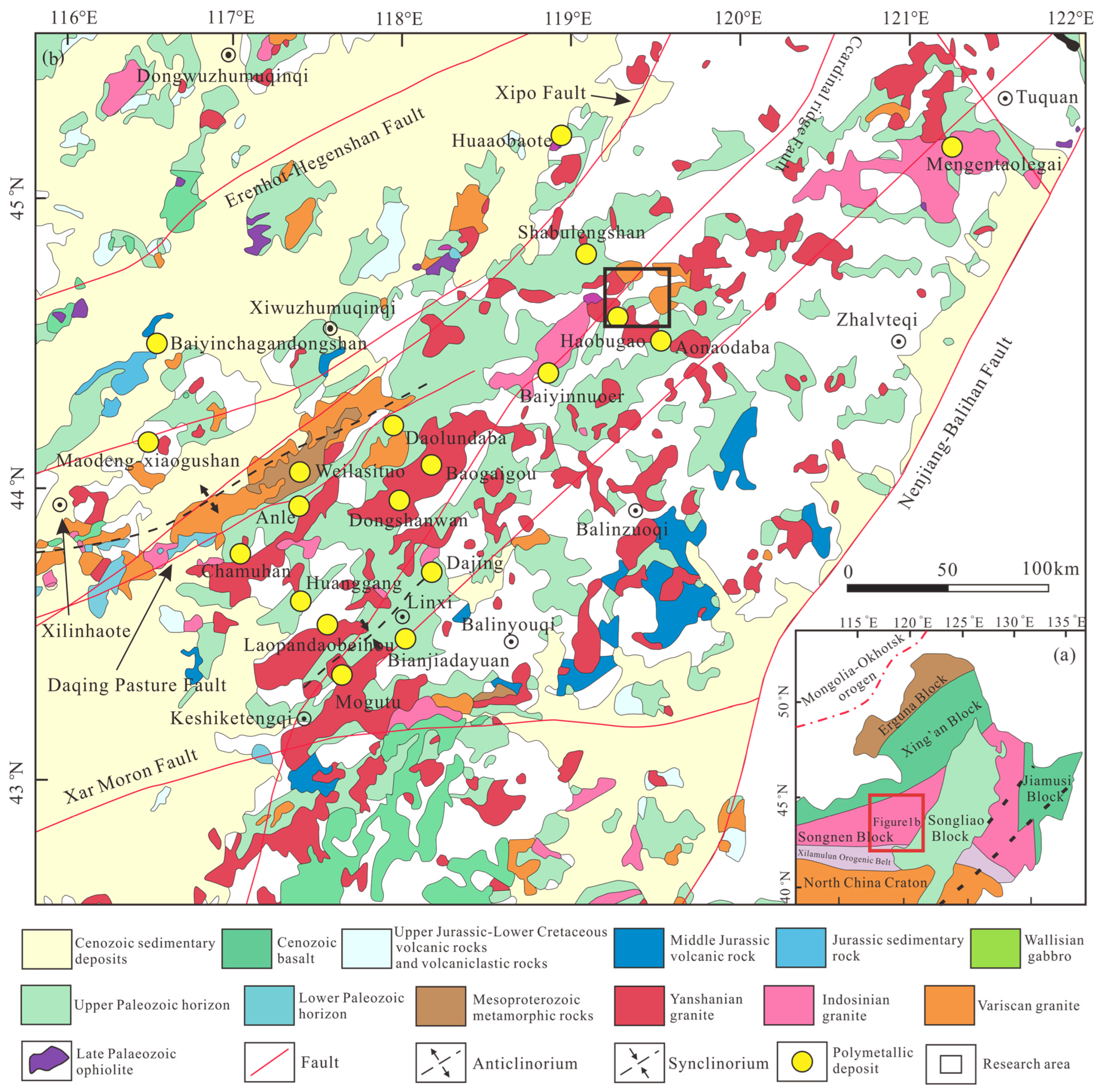
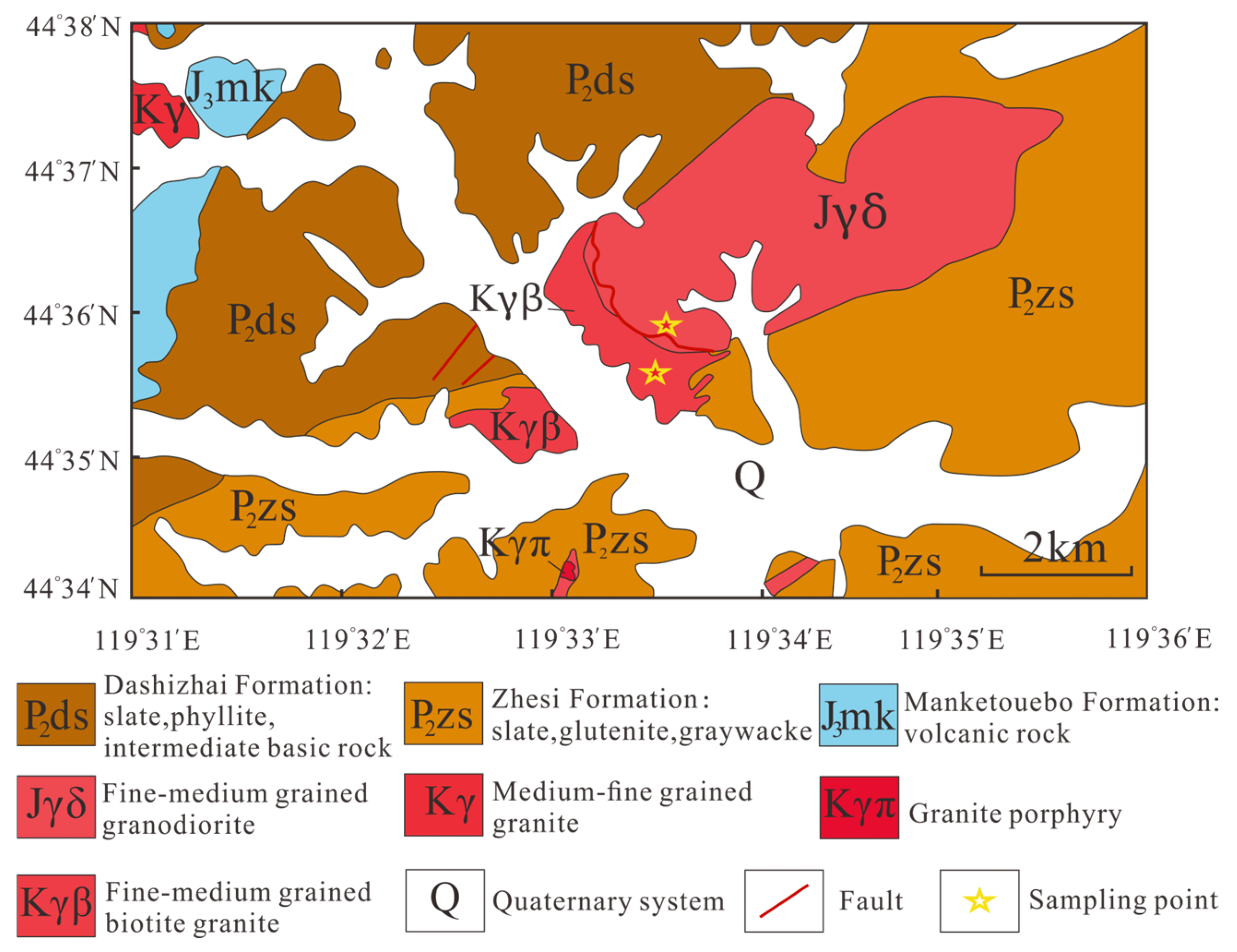
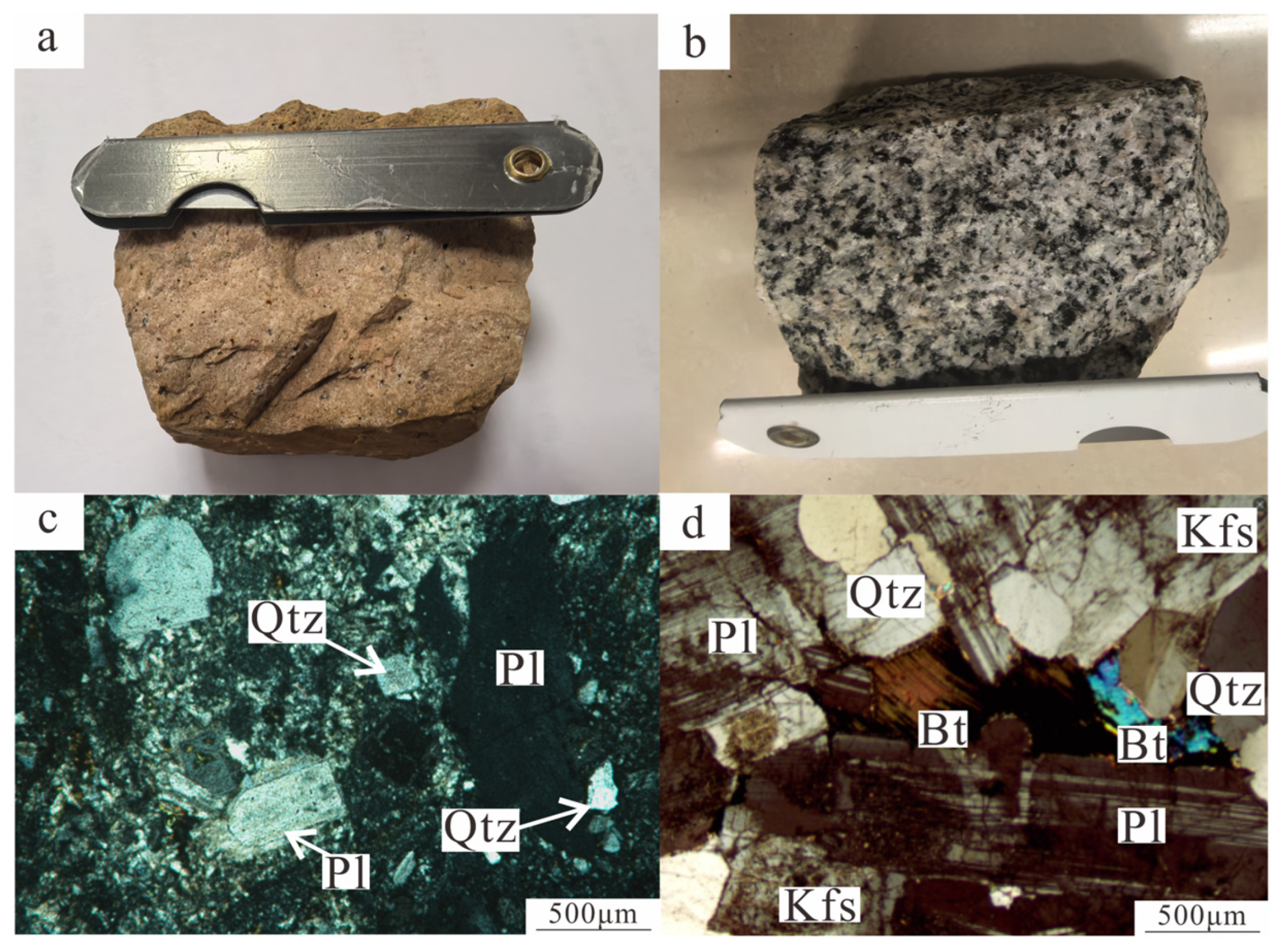
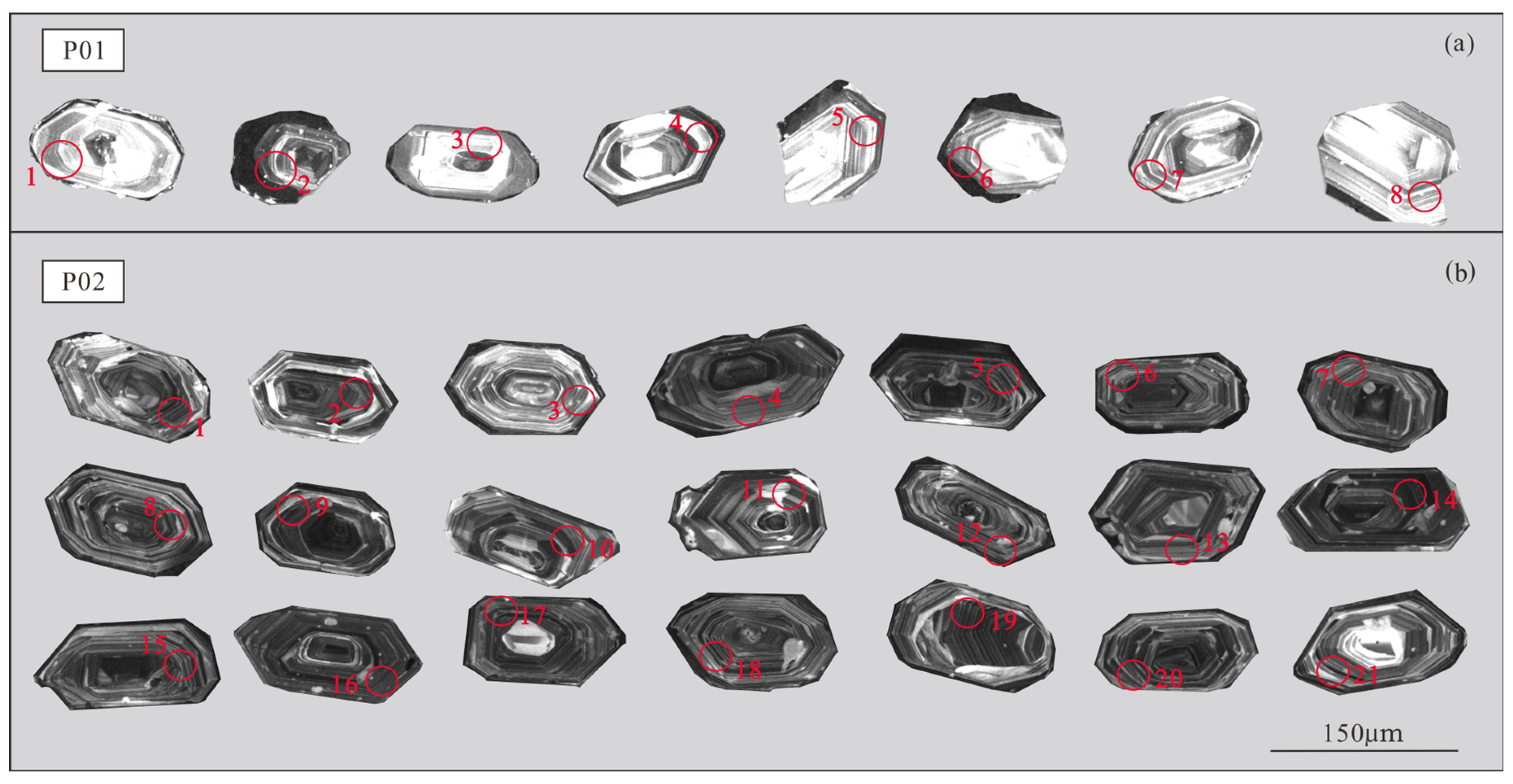
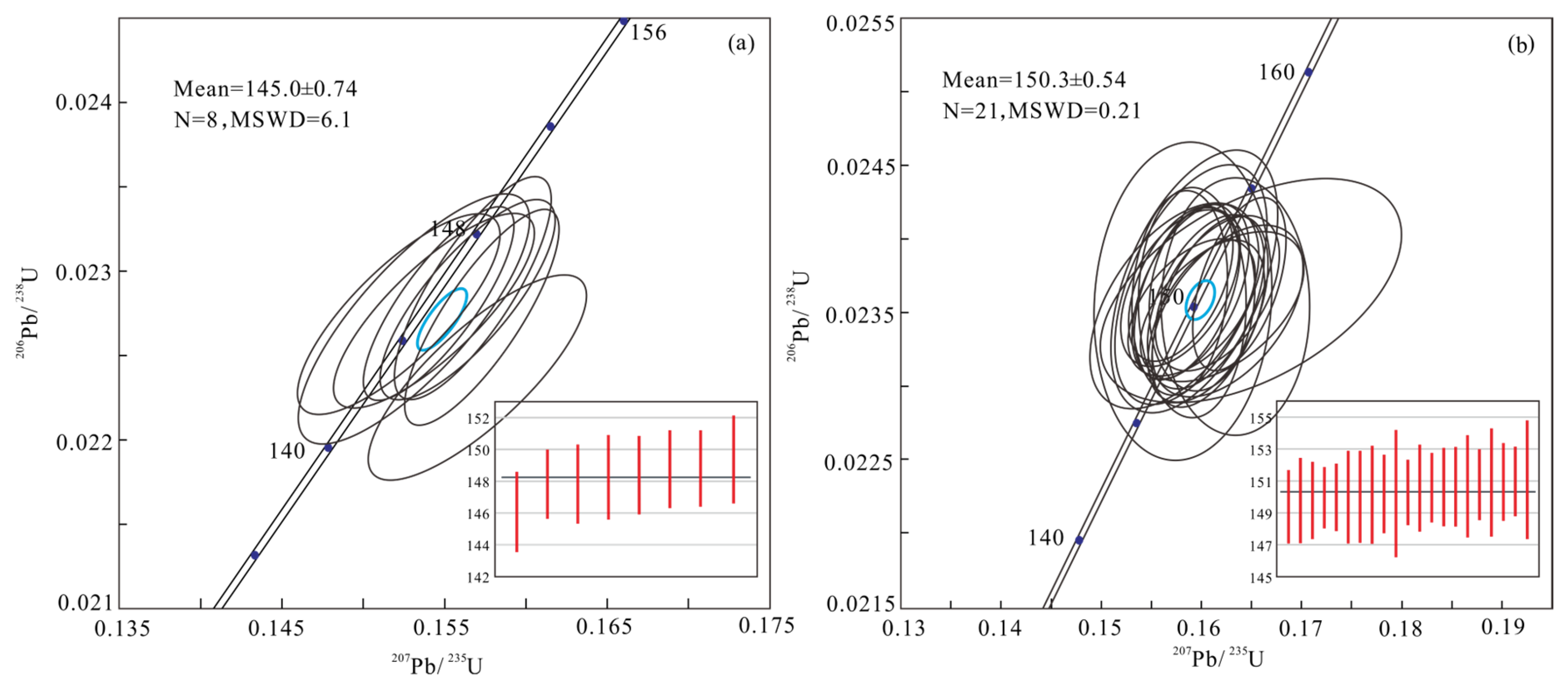
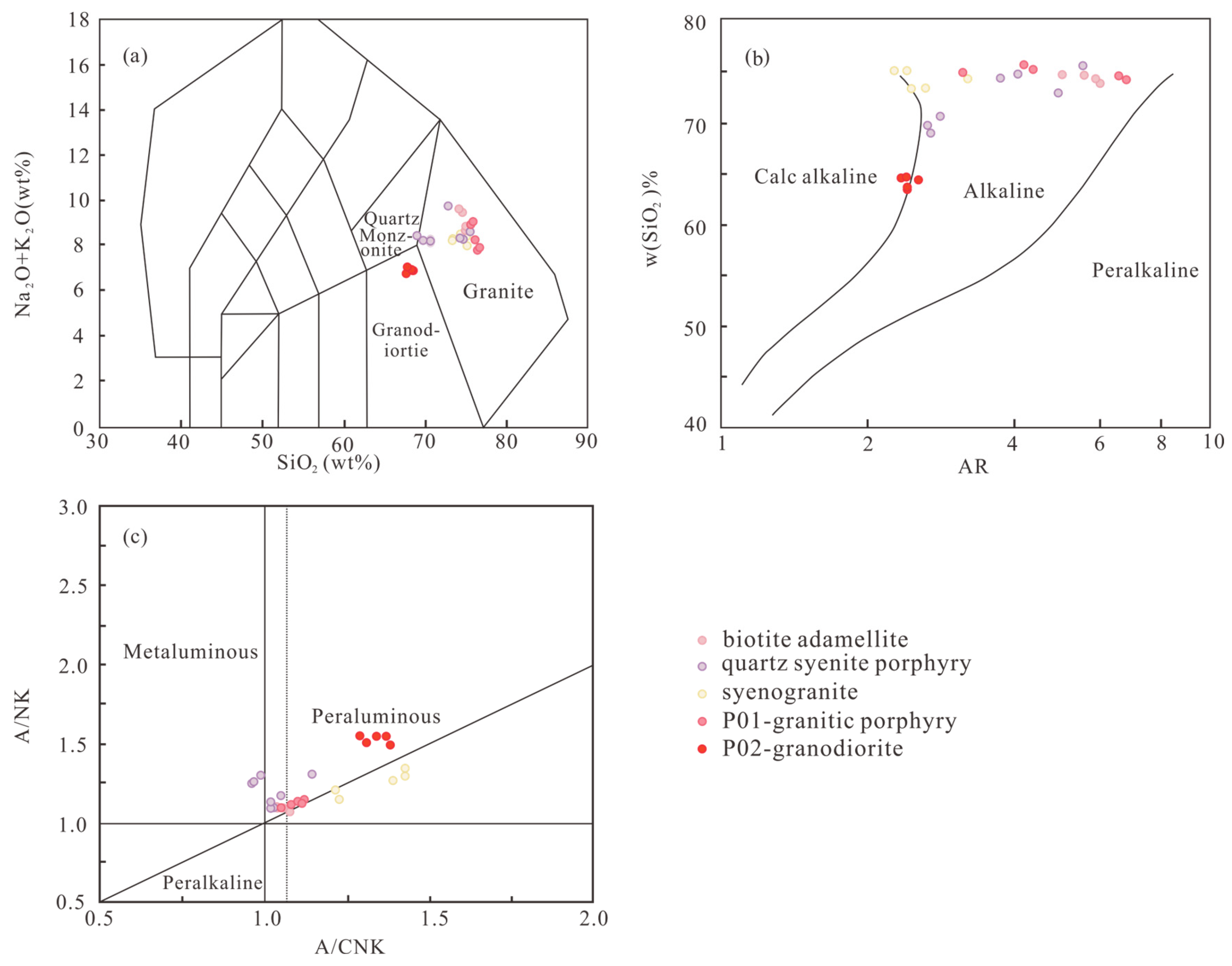
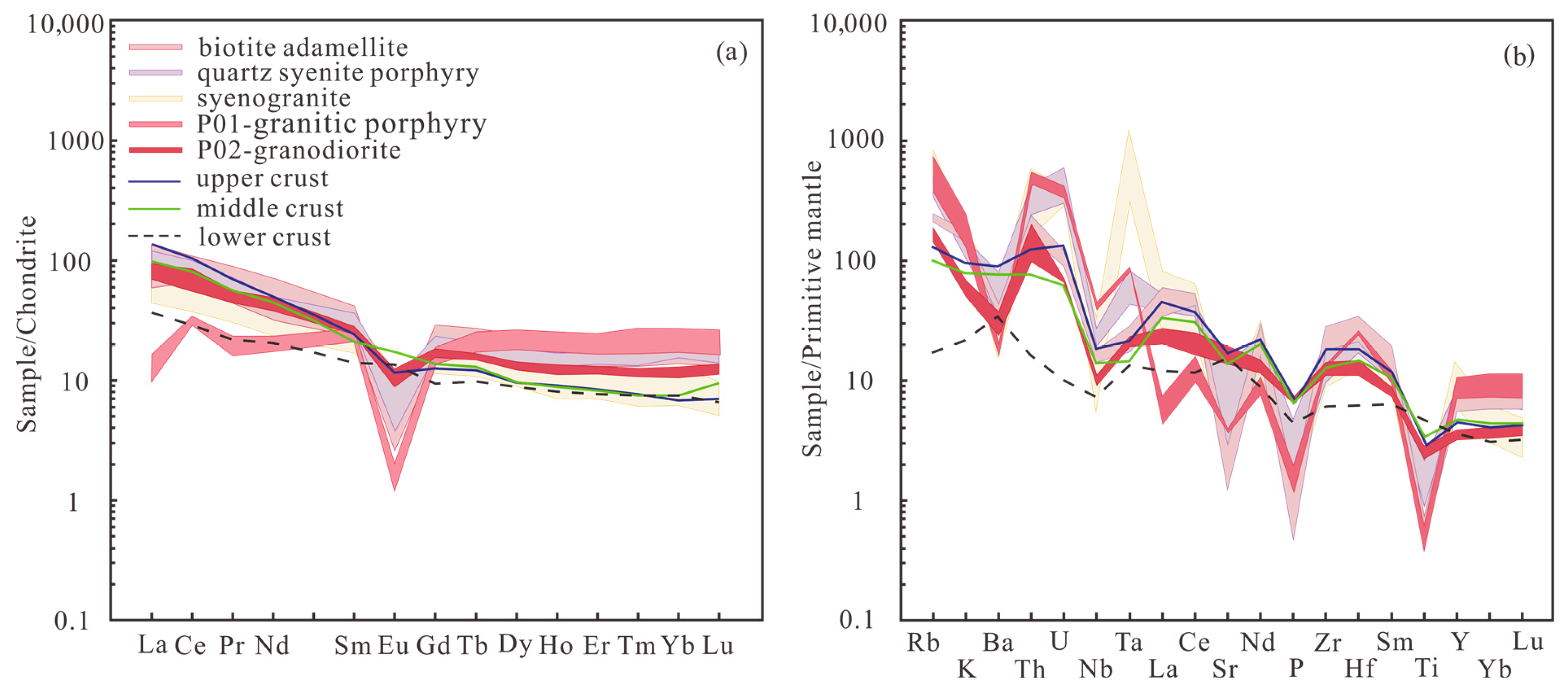

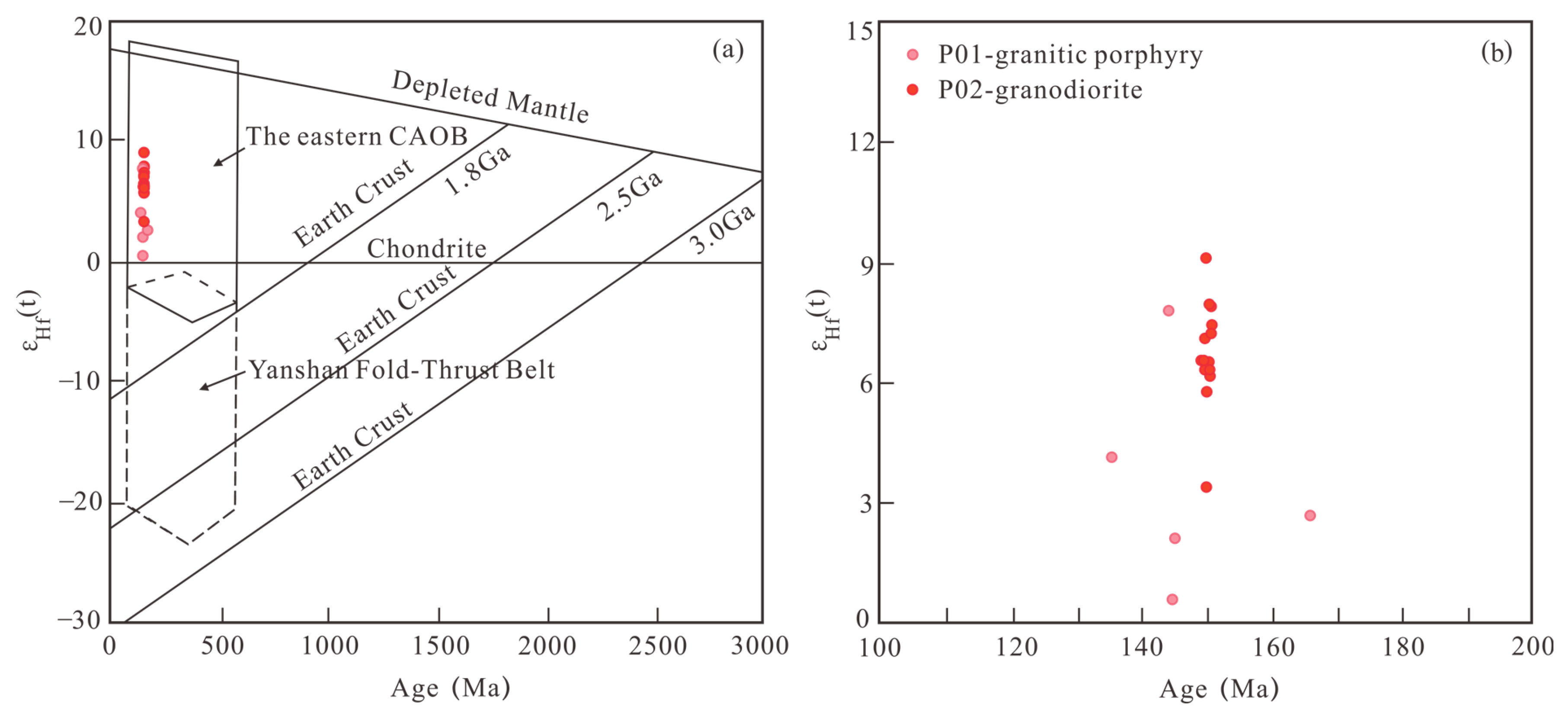
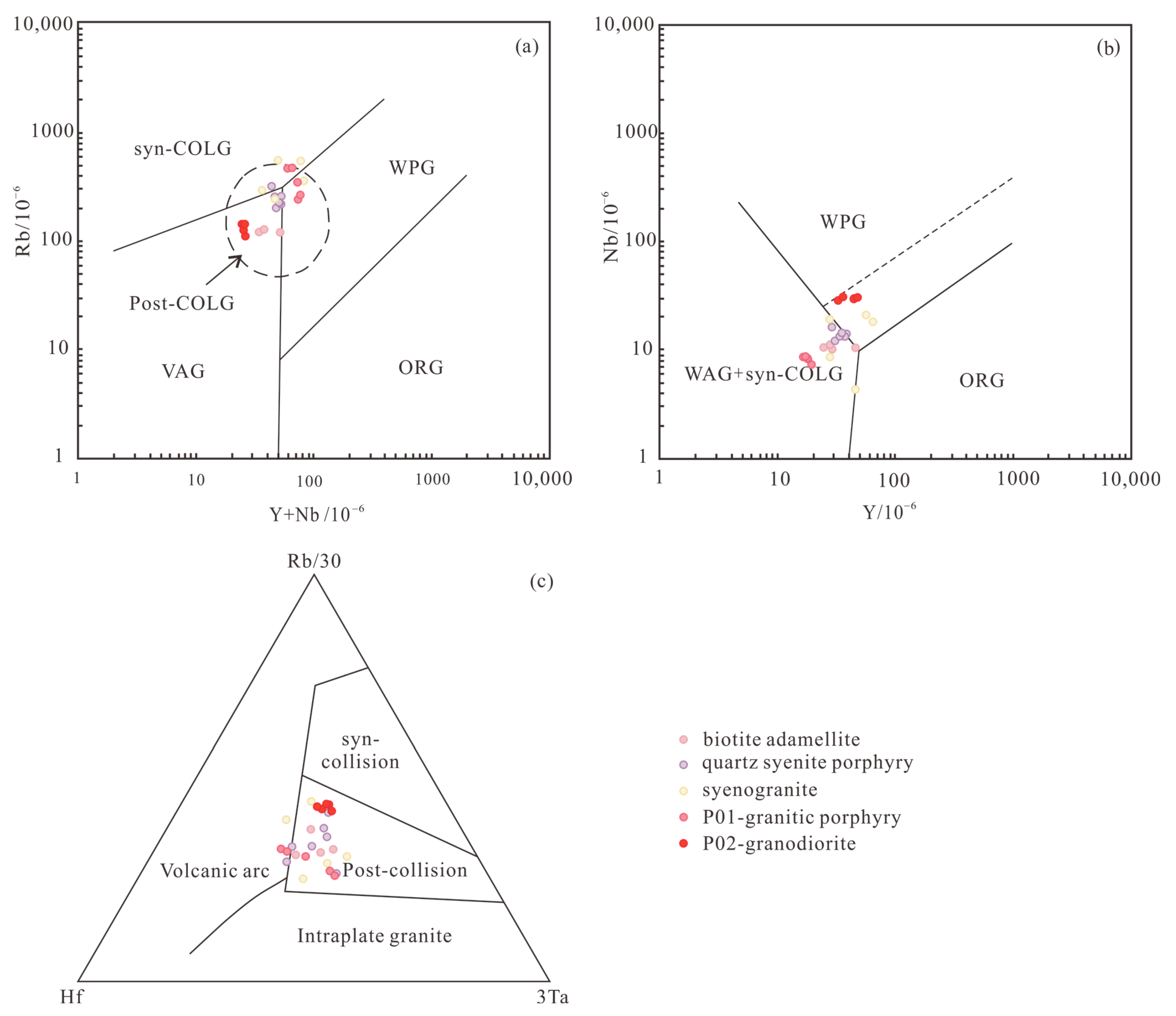
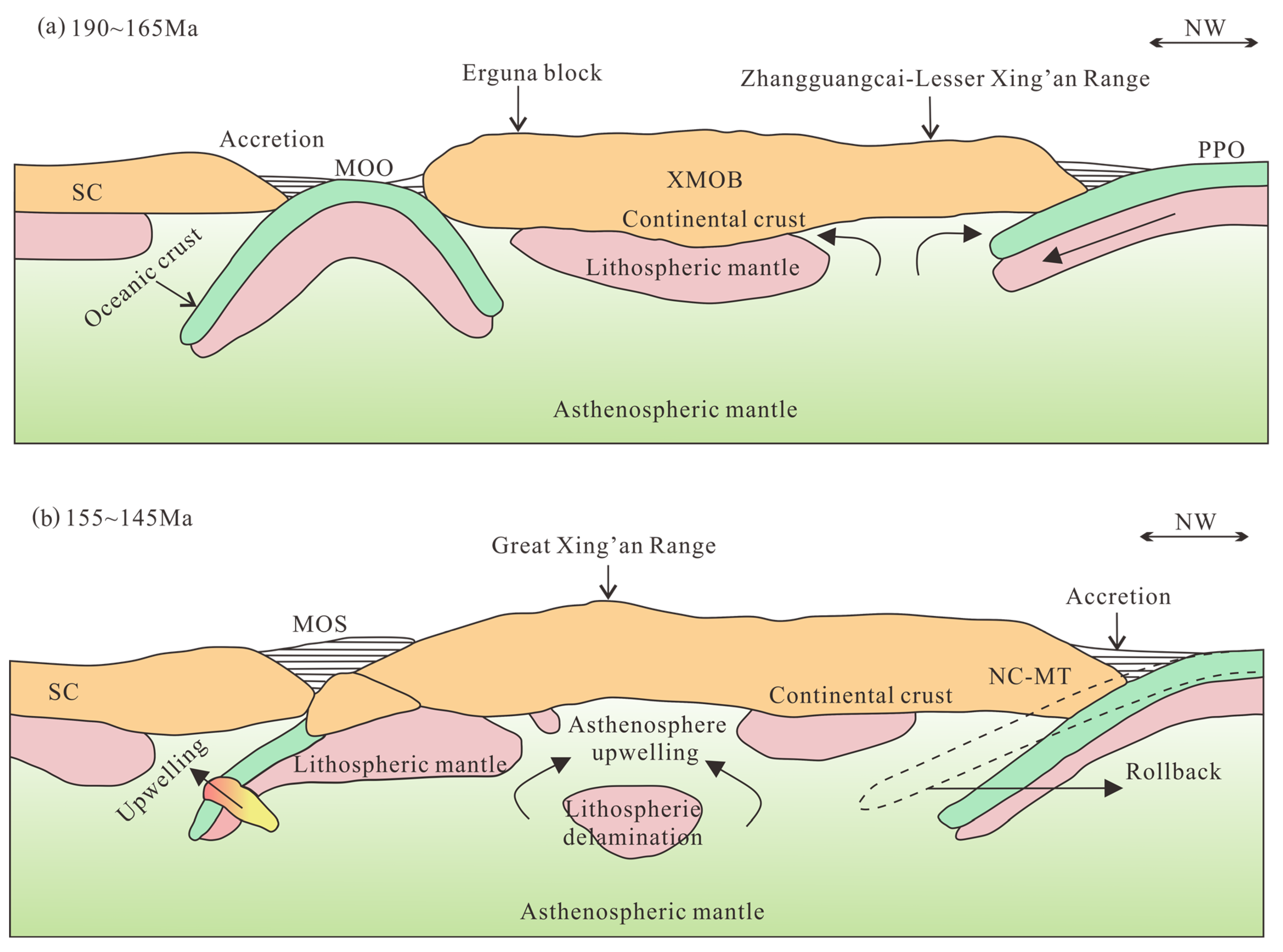
Disclaimer/Publisher’s Note: The statements, opinions and data contained in all publications are solely those of the individual author(s) and contributor(s) and not of MDPI and/or the editor(s). MDPI and/or the editor(s) disclaim responsibility for any injury to people or property resulting from any ideas, methods, instructions or products referred to in the content. |
© 2025 by the authors. Licensee MDPI, Basel, Switzerland. This article is an open access article distributed under the terms and conditions of the Creative Commons Attribution (CC BY) license (https://creativecommons.org/licenses/by/4.0/).
Share and Cite
Yue, H.; Yu, H.; Sun, Z.; He, Y.; Guan, M.; Yu, Y.; Chen, X. The Geochronology, Geochemical Characteristics, and Tectonic Settings of the Granites, Yexilinhundi, Southern Great Xing’an Range. Minerals 2025, 15, 813. https://doi.org/10.3390/min15080813
Yue H, Yu H, Sun Z, He Y, Guan M, Yu Y, Chen X. The Geochronology, Geochemical Characteristics, and Tectonic Settings of the Granites, Yexilinhundi, Southern Great Xing’an Range. Minerals. 2025; 15(8):813. https://doi.org/10.3390/min15080813
Chicago/Turabian StyleYue, Haixin, Henan Yu, Zhenjun Sun, Yanping He, Mengfan Guan, Yingbo Yu, and Xi Chen. 2025. "The Geochronology, Geochemical Characteristics, and Tectonic Settings of the Granites, Yexilinhundi, Southern Great Xing’an Range" Minerals 15, no. 8: 813. https://doi.org/10.3390/min15080813
APA StyleYue, H., Yu, H., Sun, Z., He, Y., Guan, M., Yu, Y., & Chen, X. (2025). The Geochronology, Geochemical Characteristics, and Tectonic Settings of the Granites, Yexilinhundi, Southern Great Xing’an Range. Minerals, 15(8), 813. https://doi.org/10.3390/min15080813





